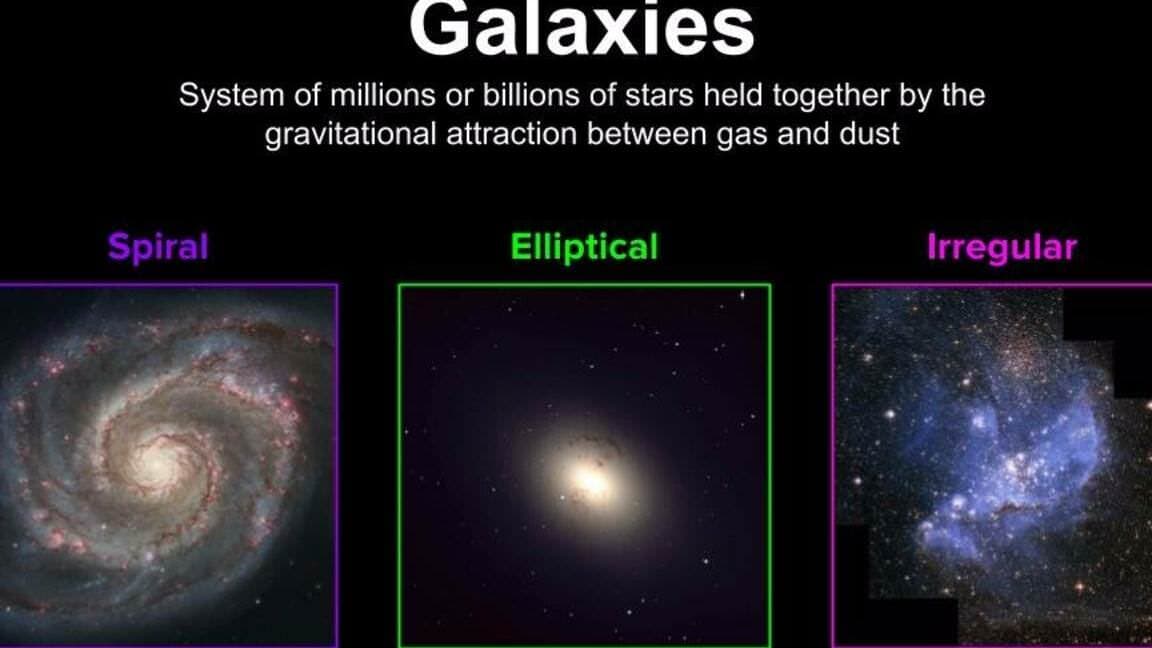
The Universe is comprised of various interconnected systems, consisting of stars, clusters, dust, gas, dark matter, energy, and planets. Gravity serves as the force that binds everything together within this vast system. It is believed that there are numerous interconnected systems present in the Universe, each differing in shape and size. Moreover, the Universe contains distinct categories and classifications of galaxies.
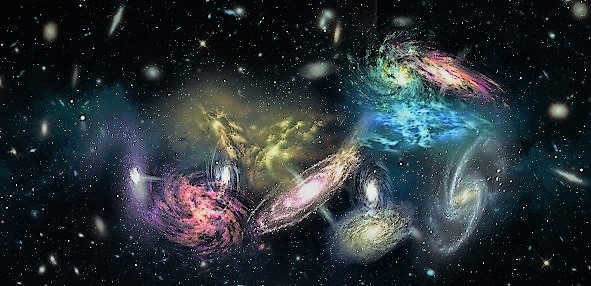
Spiral galaxies
Spiral galaxies have a distinctive flat disk shape with a highly luminous core, known as the nucleus.
Furthermore, these galaxies are distinguished by the presence of spiral arms. A classification system has been established based on the degree of their twist.
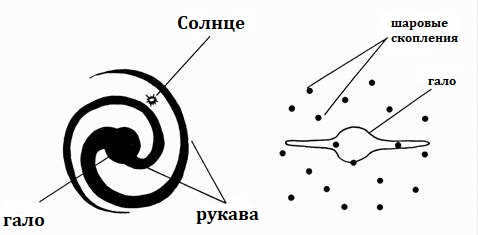
Every spiral galaxy is identified as an S galaxy.
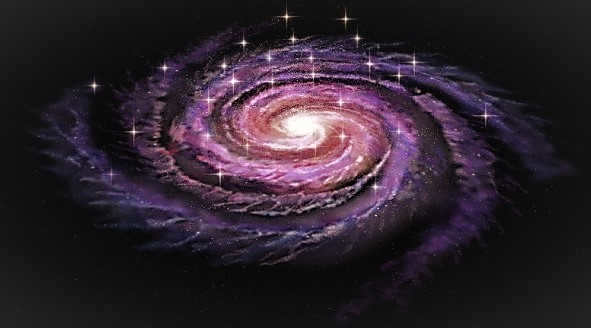
- Sa possess arms that are highly twisted;
- Some lack arms entirely, but their nuclei are noticeably luminous;
- Sb exhibit arms that are moderately twisted, with minimal arms encircling the nucleus;
- Sc have arms that are less twisted and do not encircle the nucleus.
Mesier’s catalog is widely recognized in the field of astronomy. Mesier dedicated his studies to observing and describing various celestial objects, resulting in the creation of a catalog.
One category of celestial objects described in Mesier’s catalog is spiral galaxies:
Moreover, there are spiral galaxies that exhibit a unique characteristic known as junctional spirals. Unlike traditional spiral galaxies where the spirals originate from the nucleus, junctional spirals begin at the junctions. These galaxies are labeled as Sb and further classified into subcategories such as Sba, Sbb, and Sbc. The differences between these subcategories lie in the shape and length of the spiral arms.
Mesier included the following galaxies in this group:
⦁ Mesier 58, 65, 95, and 109.
Elliptical galaxies
Elliptical galaxies come in a variety of shapes, from perfectly round to oblong-oval. It is fascinating to note that these galaxies lack a prominent nucleus and surprisingly contain very little interstellar gas. This absence of gas prevents the formation of new stars within these galaxies. However, what these galaxies lack in young stars, they make up for with a multitude of old red stars.
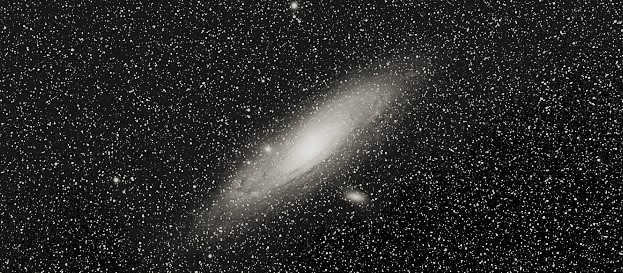
Elliptical galaxies are commonly designated with the letter E. They are categorized into different subtypes based on their shape, ranging from E0 to E7. An E0 galaxy is perfectly round, while an E7 galaxy is highly elongated.
According to the Mesier catalog, some examples of elliptical galaxies include Mesier 32, 49, 87, and 89.
It is worth mentioning that elliptical galaxies are among the largest galaxies in the entire universe.
These can be described as an intermediate form of galaxies. They possess a significant core and disk, but lack spiral arms. Furthermore, lenticular galaxies contain red giant stars, similar to those found in elliptical galaxies. Consequently, there is no interstellar gas present in them. However, the shape and movement of lenticular galaxies resemble that of spiral galaxies.
Lenticular galaxies are categorized as S0, SB1, and E8.
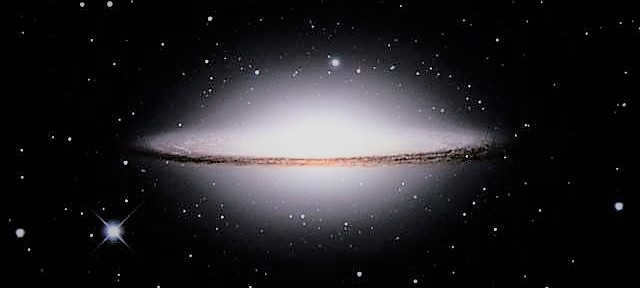
Types of Irregular Galaxies
Irregular galaxies lack a specific shape. However, due to the abundance of such formations in the Universe, these galaxies have also been categorized.
- Type I (IO) irregular galaxies are unique individual structures. Typically, they consist of young stars and nebulae.
- Type II (Im) encompasses galaxies that interact with one another. Moreover, they are often colliding and merging galaxies.
Messier has identified two irregular formations: galaxies Messier 85 and 86.
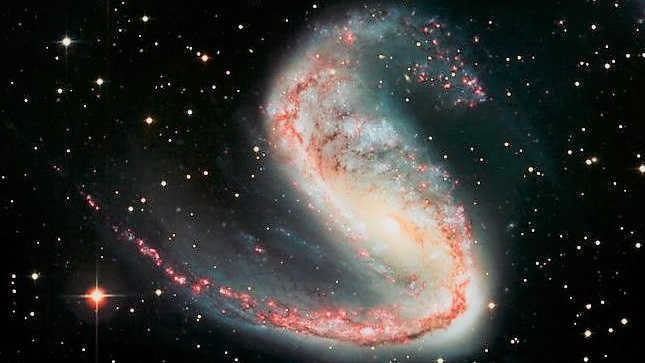
Undoubtedly, the diversity and uniqueness of galaxies are common knowledge. However, ongoing research suggests that there is still much more to discover.
Have you ever considered that the formation of the Milky Way might not follow the same pattern as the hundreds of billions of other galaxies in existence?
The known universe is home to various types of galaxies.
Indeed, galaxies are not all alike. There exists a wide range of galaxy types that are classified based on their shape or the luminosity of their stars.
The study of galaxy nature stands as one of the most crucial fields in modern astronomy.
Gaining an understanding of their composition, behavior, formation process, and even their interactions with each other is crucial to unlocking the myriad secrets of our universe.
For millennia, we believed that our solar system was the extent of existence, and that our planet was the focal point of what was believed to be a divine creation.
Later, we came to realize just how mistaken we were; there are countless stars similar to our sun, each with its own planetary systems revolving around it… and our perspectives expanded.
Our galaxy (which once seemed to encompass the entire universe) is immense, and we are but a minuscule fragment within it.
But as if that weren’t enough, we made yet another discovery: Our galaxies, which already appeared infinite with their abundance of stars and planets, are merely an insignificant speck within the vast tapestry of the entire universe.
There are numerous galaxies in the vast expanse of the universe!
The Milky Way, our very own galaxy, is truly remarkable. If you desire to gain comprehensive knowledge about this celestial wonder, simply click on our article: Milky Way: what do you really know about our galaxy?
The perception of our existence has been forever altered: we are not merely a minuscule speck, but rather a minuscule speck within another minuscule speck.
What a blow to our sense of self-importance!
The exploration of various kinds of galaxies
Ever since the invention of the inaugural telescope in 1606, we have merely scratched the surface of comprehending the astounding intricacy of the Universe and its vast magnitude. We came to the realization that our solar system was not one of a kind, with billions of others resembling it in our galaxy, but we did not cease there.
For countless centuries, we held the belief that our galaxy was the sole existence, assuming that the universe concluded at the perimeters of the Milky Way. However, nothing could be further from the truth.
It was not until 1923, when the renowned astronomer Edwin Hubble began to observe something peculiar within what seemed to be an exceedingly distant star cluster.
The discovery led to a single conclusion: our galaxy does not represent the entire universe, but the question remains: how many galaxies are there?
The collection of stars observed by Hubble beyond our galaxy turned out to be what we now know as Andromeda, our closest neighboring galaxy, located just 2.5 light years away.
Another intriguing fact is that Andromeda did not appear to be identical to the Milky Way, our galaxy (even though they were often referred to as “twin galaxies”). This raised an important inquiry: are there various types of galaxies in the Universe?
Since then, nearly a century ago, numerous astronomers and astrophysicists have been fully devoted to identifying and comprehending the different types of galaxies that exist in the universe. The findings are truly captivating.
Studying the various types of galaxies: A new perspective
In 1923, a breakthrough was made when we caught a glimpse of a neighboring galaxy for the very first time. However, exploring and understanding other galaxies has long been a formidable task, especially with the limited capabilities of 20th-century instruments.
The immense distances that separate us from these galaxies made it challenging for traditional telescopes to gather reliable data about celestial objects in the depths of space.
Fortunately, everything changed in 1990 with the launch of the groundbreaking Hubble Super Space Telescope by NASA.
Unlike its predecessors, this state-of-the-art telescope is equipped with specialized lenses that are sensitive to a wide range of wavelengths, including infrared, ultraviolet, X-ray, and gamma-ray emissions resulting from nuclear fusion processes on the surfaces of countless stars.
What has Hubble’s exploration revealed?
The Milky Way and Andromeda are not two solitary sisters wandering aimlessly in the vast expanse of the universe. In reality, they are the elder siblings of a galactic cluster comprising a total of 46 galaxies, which in turn is a minuscule fraction of the “superconglomerate” galactic, encompassing over 5,000 distinct galaxies.
The crucial term here was “distinct.”
With such a vast array of examples to examine, scientists have discovered that not all galaxies are alike, and many are not even as similar to each other as the Milky Way and Andromeda (both spiral galaxies).
Thus, towards the close of the 19th century, a query emerged that would shape astronomical research in the ensuing years: How many categories of galaxies exist, and what forms do they take?
The Hubble classification: measuring galaxies in a unique way
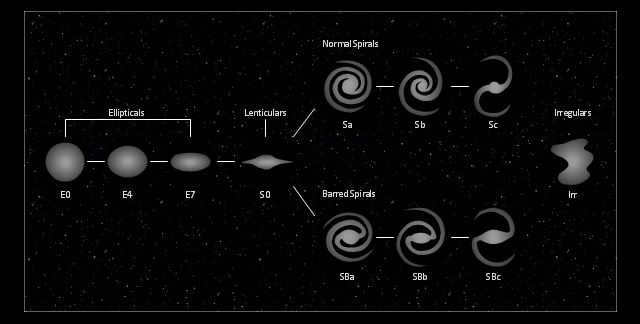
The Hubble sequence is a classification system used to categorize the various shapes of galaxies based on their appearance.
Following the groundbreaking discovery of the Andromeda galaxy in 1923, Edwin Hubble dedicated his efforts to identifying and classifying the different galaxy types.
As a result, he developed the Hubble Sequence, also known as the Chamberlain Chart, which provides a comprehensive framework for understanding the diverse range of galaxy shapes.
This sequence encompasses the various types of galaxies based on their shape, which is determined by the arrangement of cosmic gases and stardust within them.
Furthermore, each shape category is further subdivided based on factors such as mass, diameter, and luminosity.
- Regular
- jumper spirals
- intermediate spiral
- square elliptical
- discoidal elliptical
Categories of galaxies based on their shape
Galaxies are primarily composed of stardust, which revolves around a galactic center (typically a black hole) along with stars, planets, and other cosmic objects.
The arrangement of galaxy bodies around the nucleus can vary, resulting in different types of galaxies in our classification system.
There are three main categories of galaxies based on their shape: elliptical, spiral, and lenticular.
A fourth category, irregular galaxies, has also been introduced recently. This category includes various types of galaxies that do not fit into the other classifications.
Elliptical galaxies
Elliptical galaxies are a type of galaxy that has an elliptical shape. They are characterized by their smooth and featureless appearance, as well as their lack of spiral arms. These galaxies are typically composed of older stars and have little to no ongoing star formation.
One interesting feature of elliptical galaxies is their classification system, which is based on their shape and elongation. They are classified into different types, ranging from E0 (round) to E7 (highly elongated). The classification system helps astronomers better understand the properties and evolution of these galaxies.
Elliptical galaxies are often found in galaxy clusters, where they make up a significant portion of the population. They are thought to have formed through a variety of processes, including mergers of smaller galaxies and the stripping of gas from spiral galaxies.
Despite their lack of ongoing star formation, elliptical galaxies can still be active in other ways. Some of them contain active galactic nuclei (AGN), which are supermassive black holes at the centers of galaxies that are accreting mass and emitting large amounts of energy.
Overall, elliptical galaxies are fascinating objects that continue to intrigue astronomers with their unique properties and formation processes. Their study helps us better understand the universe and the role that galaxies play in its evolution.
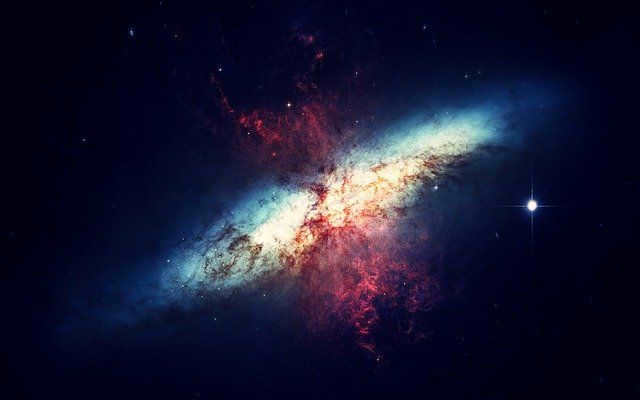
Elliptical galaxies are a common presence in our vast Universe. They possess a grandeur that often surpasses that of their spiral counterparts due to their formation through multiple collisions between smaller galaxies over the course of millions of years.
Consequently, elliptical galaxies acquire a distinctive elongated shape resembling an ellipse, hence their name. However, their constituent elements lack any discernible order or organization.
In these galaxies, stars, planets, planetoids, dust clouds, and asteroids move in a haphazard manner, devoid of any apparent gravitational pattern as observed in spiral galaxies. Consequently, their structure remains elusive and ill-defined.
The main composition of elliptical galaxies consists of old, massive stars, resulting in significantly lower concentrations of stardust. Consequently, the birth rate of new stars within these galaxies is estimated to be extremely low, approaching zero.
Spiral galaxies
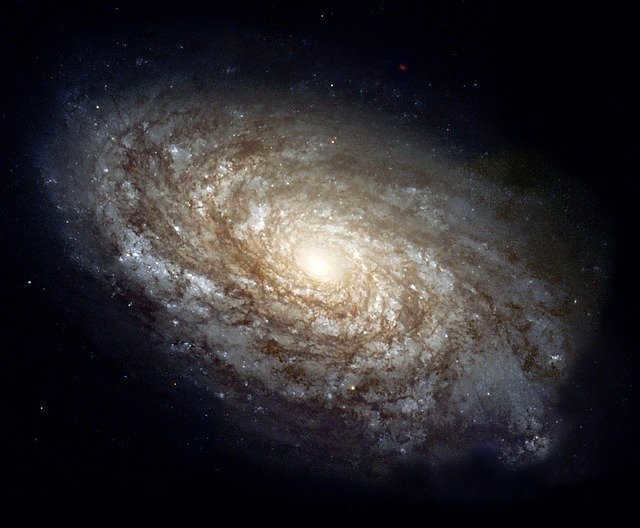
Spiral galaxies, like our own Milky Way, possess a more distinctive body shape in comparison to elliptical galaxies. In this instance, the entire mass of the galaxy revolves around a central nucleus in an orderly manner.
The galactic nucleus or bulge can have a diameter spanning several light years and is primarily comprised of a dense cluster of massive stars, resulting in the highest level of luminosity being present in its central region.
However, upon further examination towards the core, something of great significance is revealed: the massive stars of the bulge typically orbit around an even denser point of matter – a black hole, which emits the entirety of the gravitational force that governs the entire galaxy.
For instance, our own galaxy is governed by a supermassive black hole known as Sagittarius A.
As we venture farther from the core of the Milky Way galaxy, we find ourselves in a vast disk. This disk is home to the majority of the spiral galaxy’s mass, including stars, planets, and interstellar dust.
The disk’s rotation around the gravitational center causes it to take on a distinctive spiral shape, with several eccentric arms extending outward.
Our own galaxy, for instance, is composed of two well-known major arms: the Centaurus Shield and Perseus, as well as several smaller density branches such as the Orion Prominence, Sagittarius, and Norma.
Spiral galaxies can be categorized from S01 to S07 based on the extent of their arm eccentricity. The more open the arms are towards the galaxy’s core, the higher their ranking in the classification system.
Lenticular galaxies
Lenticular galaxies, which are currently classified as such, are believed to be in a transitional phase between elliptical and spiral galaxies. Despite their disk-like shape and presence of arms, the loss of interstellar matter has caused them to fade away.
Due to the lack of eccentricity in their arms, lenticular galaxies are classified as S0 on the Hubble scale.
Irregular galaxies contain abundant interstellar dust clouds and young dwarf stars. However, they are a relatively small subset, accounting for only 3% of observed galaxies that fit the lenticular galaxy classification.
What are the potential transformations lenticular galaxies can undergo?
Lenticular galaxies are essentially spiral galaxies that have yet to reach the stage of maturity or accumulation of sufficient matter to form a typical spiral shape.
Unconventional Galaxies
Unconventional galaxies continue to baffle the field of modern astronomy, defying categorization within the well-established Hubble sequence.
These peculiar galaxies lack a discernible structure in the distribution of their matter, straying from both elliptical and spiral formations.
Their matter accumulates as random disturbances in space, without any discernible rotation around a central gravitational point, resulting in a complete absence of order or system. Their irregular shapes resemble luminous specks suspended in the vastness of space.
Unconventional galaxies consist of a diverse range of elements, including asteroids, significant amounts of gas and dust, as well as young and small stars.
Alternative categorizations of galaxies in the cosmos
Galactic classifications are not solely based on the arrangement of their matter; they also take into account the quantity and nature of the radiation they release into the expanse of space.
Galaxies that generate enough energy to emit substantial quantities of electromagnetic radiation outward are identified as active galaxies.
These types of galaxies emit electromagnetic waves not due to the standard constituents of a galaxy (such as stardust, stars, and planets), but rather due to extraordinary processes that typically unfold in the core of the galaxy.
Such galaxies possess what is known as an active galactic nucleus (AGN).
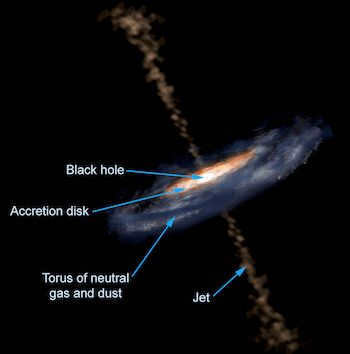
It is believed that active galactic nuclei (AGNs) form when large concentrations of dust or material are pulled into the supermassive black hole at the center of a galaxy.
Due to the intense gravitational forces, the matter heats up and transforms into plasma, generating powerful magnetic fields that are expelled from the galaxy at high speeds.
Not every galaxy is capable of producing this phenomenon, as there are various factors that determine its occurrence. In fact, only 10% of galaxies observed from Earth exhibit this physical phenomenon.
There are different classifications of active galaxies based on the amount and type of energy they emit outward.
Seyfert Galaxy
Seyfert galaxies are generally characterized as spiral galaxies that have an extremely luminous core and a significant concentration of mass in their central regions.
As interstellar matter falls into a black hole within a Seyfert galaxy, it produces distinctive spectral emission lines that primarily consist of hydrogen, helium, and carbon atoms.
Formation of Stars in Galaxies
Galaxies that undergo star formation are a unique type of galaxies that lack the generation of electromagnetic fields caused by particle jets emitted from an active galactic nucleus.
In these cases, the energy released is a result of multiple concurrent bursts of star formation. Consequently, these galaxies exhibit a significantly higher rate of new star birth compared to other galaxies, resulting in the release of more energy into the surrounding space.
During this process, stellar winds carry away an excess concentration of hydrogen molecules, leading to the formation of high-energy electromagnetic fields that are expelled from the core of the galaxy into space.
The information presented in this article adheres to our editorial ethics guidelines. Please click here to report any errors.
Full article path: postpost ” Science ” Types of galaxies How many types of galaxies are there?
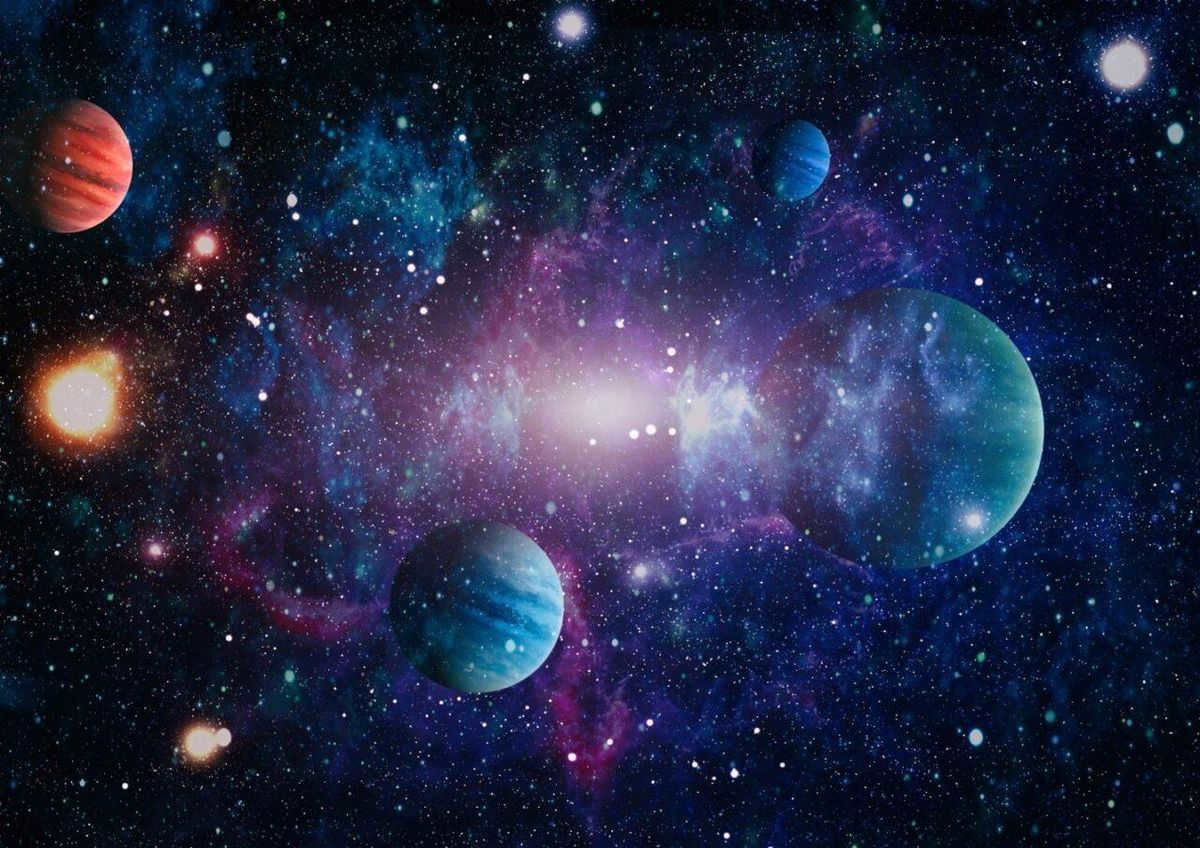
Human curiosity is a powerful driving force that compels us to constantly seek out new knowledge and explore the unknown. However, there are certain natural phenomena that elude our grasp and require a more extensive analysis. One such enigma is the galaxy. The vastness of the universe is mind-boggling, and it would take a lifetime to fully comprehend it. For years, humans have dedicated their efforts to unraveling its mysteries and delving into its intricate details.
To comprehend the distinction between a galaxy and the universe, it is essential to grasp the fundamentals of these concepts.
The universe encompasses the entirety of space surrounding an individual. Every existing material entity is a component of the universe. Hence, in most cases, this term is written with a capital letter. The universe is vast, with its precise magnitude still uncharted by mankind. Astronomers dedicate their efforts to the exploration of this aspect. However, despite their expertise and countless investigations, their understanding remains limited. Year after year, astronomers diligently observe cosmic entities and endeavor to study them. Nevertheless, the vast expanse of the universe remains shrouded in mystery.
A galaxy is essentially a single entity within the vast expanse of the universe. It consists of a large group of stars orbiting around a central point. Galaxies come in a variety of shapes and sizes, each possessing its own unique appearance. However, regardless of their differences, every galaxy is significantly larger than the Earth.
The smallest galaxy measures approximately 1000 light years in diameter and contains around 1,000 stars. On the other hand, the largest known galaxies span up to 6 million light years and are composed of over 1000 trillion stars. The study of these immense structures requires years of dedicated research. The constant discovery of new phenomena within galaxies serves as a driving force for scientists to further their investigations.
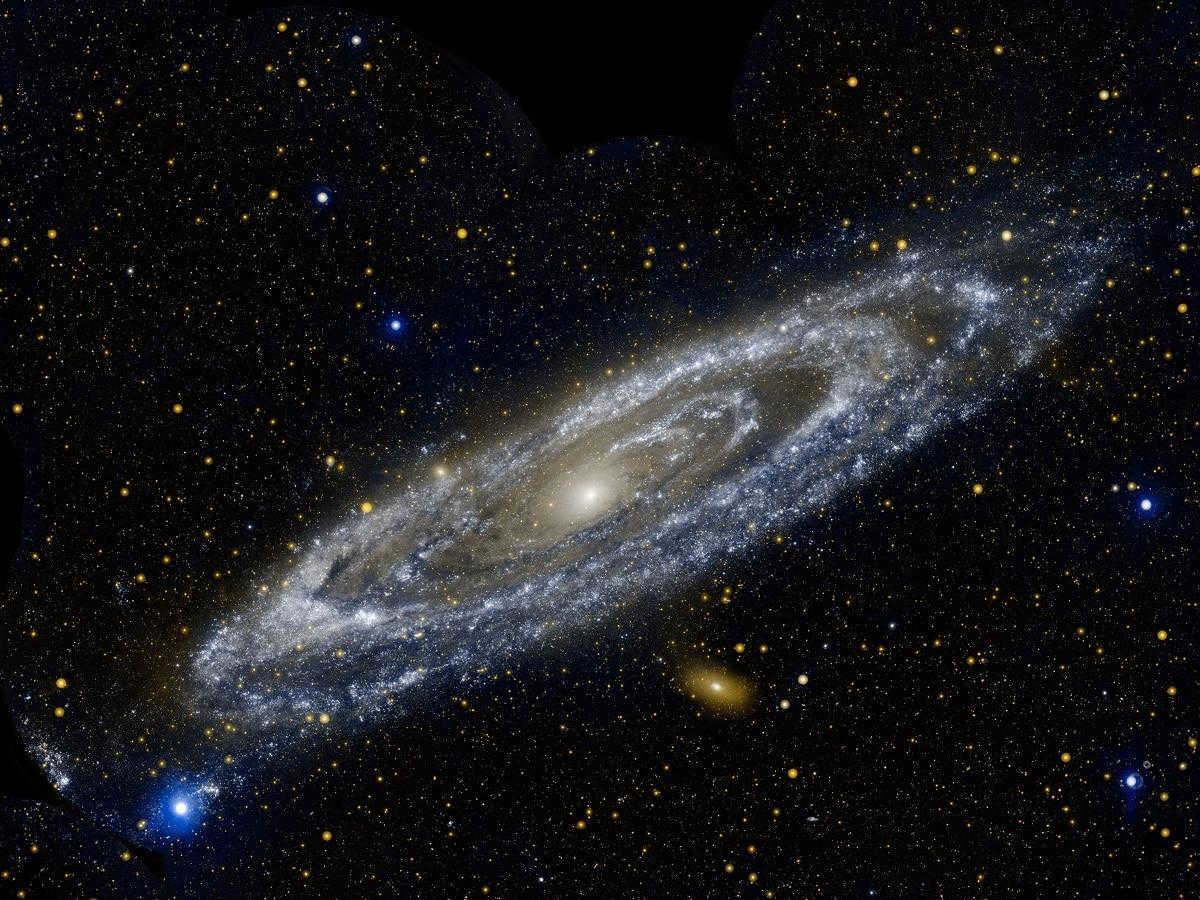
The Hubble sequence
In order to simplify the study of galaxies, a special classification system for these objects was developed. The initial scheme, proposed by Edwin Powell Hubble in 1926, is widely utilized in contemporary astronomy. Over time, this classification has undergone several refinements.
It is primarily based on the structure of the predominant known galaxies. According to this classification, all galaxies that currently exist are categorized into several types:
- spiral (S);
- elliptical (E);
- Irregular (Irr);
- barred-bar galaxies (SB);
- lenticular (S0).
The classification proposed by Hubble was introduced a decade after the previous classifications were published. There are certain galaxies that are too faint to be classified and examined, and these objects are typically denoted as “Q”.
Numerical values are also effectively utilized to aid in classifications, such as indicating the degree of flattening in an elliptical galaxy. The letter designations generally signify the proximity of the spiral galaxy’s arms to the nucleus.
The Hubble sequence enables astronomers to categorize and differentiate objects more expediently.
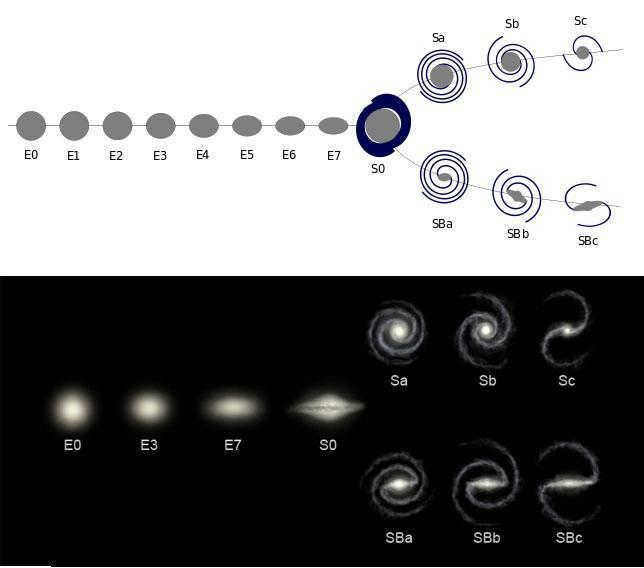
Elliptical Galaxy
Elliptical galaxies are celestial objects that have a spherical or elliptical shape. The main distinguishing feature of these galaxies is the absence of a disk-shaped component. The letter “E” is used to classify elliptical galaxies. Unlike other types of galaxies, elliptical galaxies lack white-blue giants and supergiants, as well as dusty matter.
While visually similar to each other, elliptical galaxies can vary in terms of their compression. The closest elliptical galaxy to Earth is a dwarf galaxy located in the Sculptor constellation, with a radius of 1505 light-years.
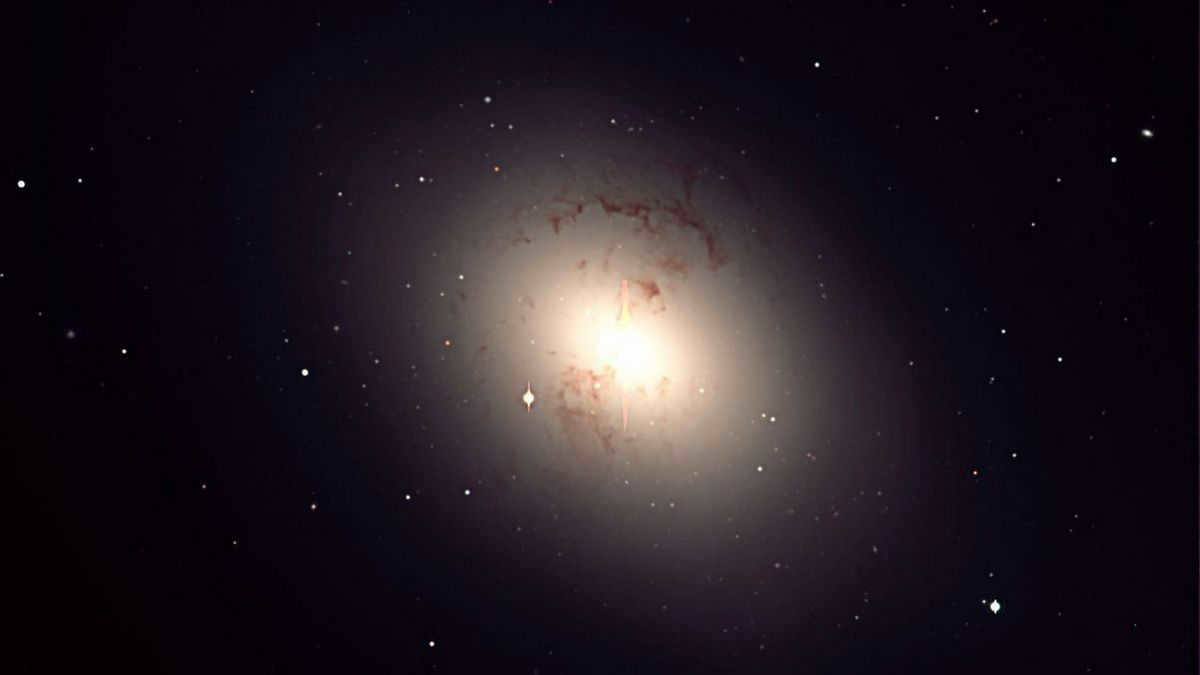
A spiral galaxy
A spiral galaxy is a vast assemblage of disk-shaped stars adorned with spiral arms. Some scientists liken the appearance of spiral galaxies to the graceful rotation of windmills.
Almost all spiral galaxies possess arms that possess a compacted core with spirals extending inward. Approximately 60% of identified galaxies are spiral galaxies. This is one of the most prevalent categories.
A spiral galaxy also possesses a spherical halo; it envelops the disk almost entirely. The halo consists of small quantities of dust and gas. Within the spherical halo, one can find ancient stars that have coalesced into distinct clusters.
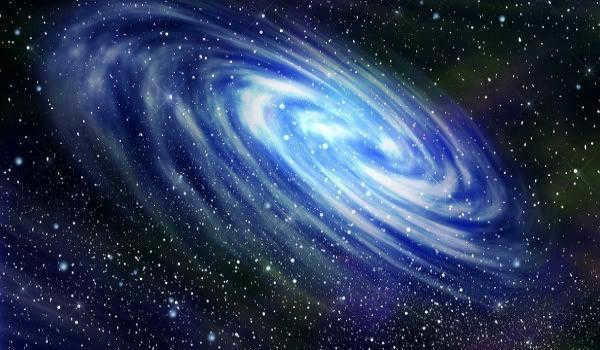
A unique type of galaxy
According to the classification by Hubble, lenticular galaxies occupy a middle ground between elliptical and spiral galaxies. Each lenticular galaxy possesses a stellar disk that surrounds a globular cluster. The arms of these galaxies are relatively small and have a faint appearance.
One distinguishing characteristic of lenticular galaxies is that no new stars are formed within them. The amount of gas and dust present is insufficient for the creation of new celestial bodies. The majority of lenticular galaxies consist of aged yellow and red stars.
These celestial objects vary in lintel density, the quantity of stardust present, and the size of their galactic centers. Lenticular galaxies make up approximately 20% of all known cosmic objects.
Despite their rarity, lenticular galaxies are actively studied.
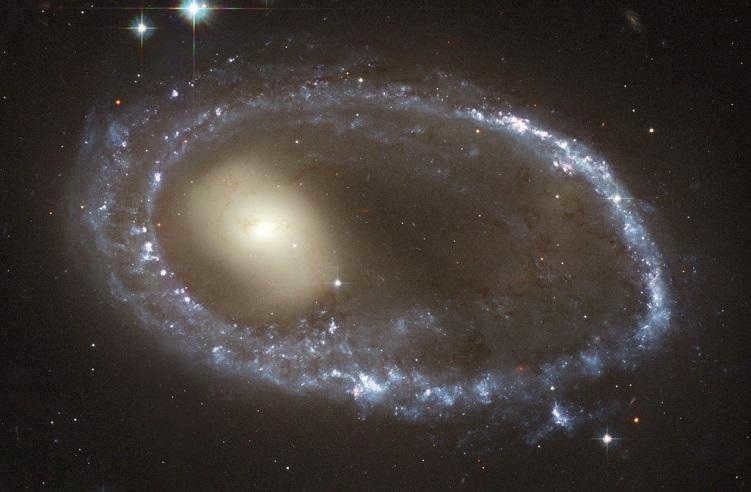
Types of Irregular Galaxies
Irregular galaxies are named as such because they lack a specific shape, unlike elliptical or spiral galaxies. These objects do not fit into any specific classification, so a separate section in astronomy is dedicated to them.
Irregular galaxies are typically chaotic star clusters without a defined shape or size. Many of them don’t even have a center. Only 5% of irregular galaxies have been identified, while the rest can be classified based on their specific characteristics.
There are two types of irregular galaxies:
- Irr I: These irregular galaxies possess some structure that allows them to be categorized within the Hubble sequence.
- Galaxies lacking any resemblance in structure (Irr II).
This is the sole classification option that enables us to organize these entities to some extent.
Occasionally, distinctive, diminutive irregular galaxies (dl or dllrr) are distinguished. They prove exceptionally challenging to detect, consequently, even seasoned astronomers and scholars possess limited knowledge on the subject.
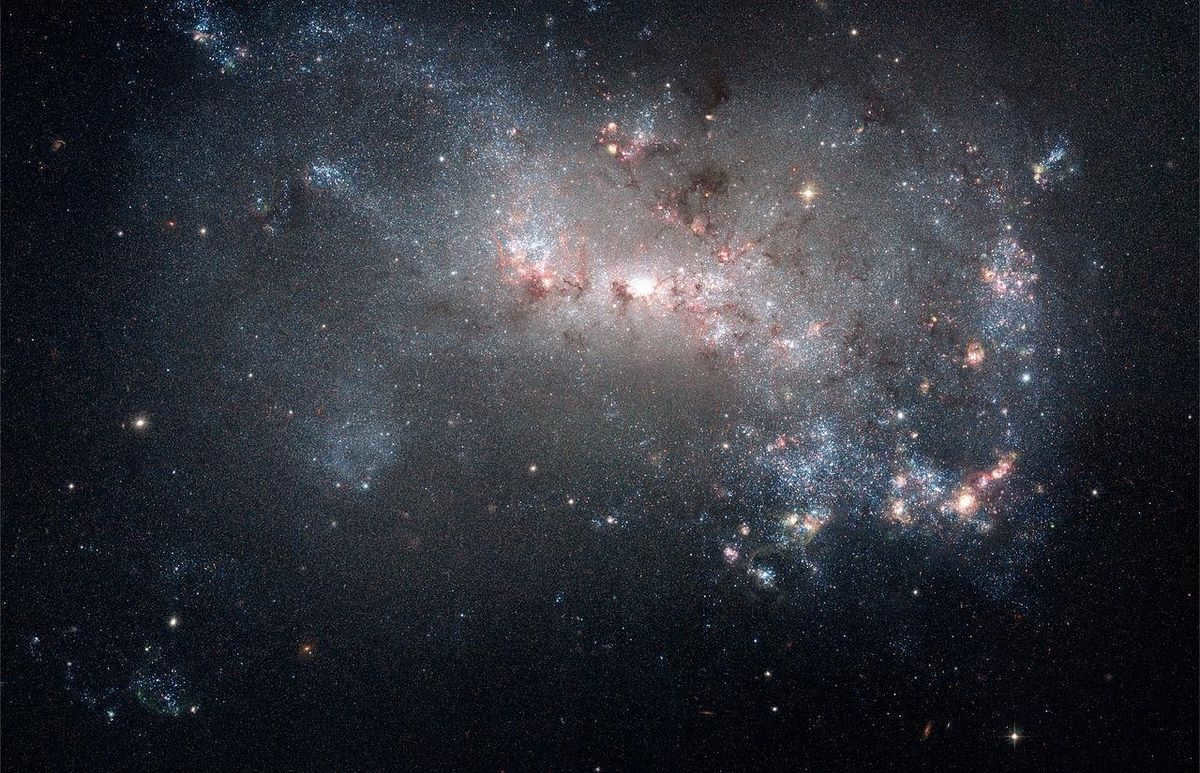
Galaxies with Polar Rings
A rare type of galaxy is one that possesses a polar ring. The polar ring is an outer ring composed of gas and stars that orbit above the poles of the galaxy. Scientists have discovered that polar rings form when two galaxies interact gravitationally.
Another hypothesis suggests that polar rings may be created through the gravitational pull of a passing galaxy, utilizing tidal interactions. Despite many theories and hypotheses, a definitive answer to this question remains elusive.
While most galaxies with polar rings are classified as lenticular objects, there are also instances of other galaxy types, including elliptical galaxies.
It was not until 1978 that the initial polar ring galaxies were recognized. Once scientists acquired valuable data on these entities, they became capable of detecting and categorizing comparable galaxies.
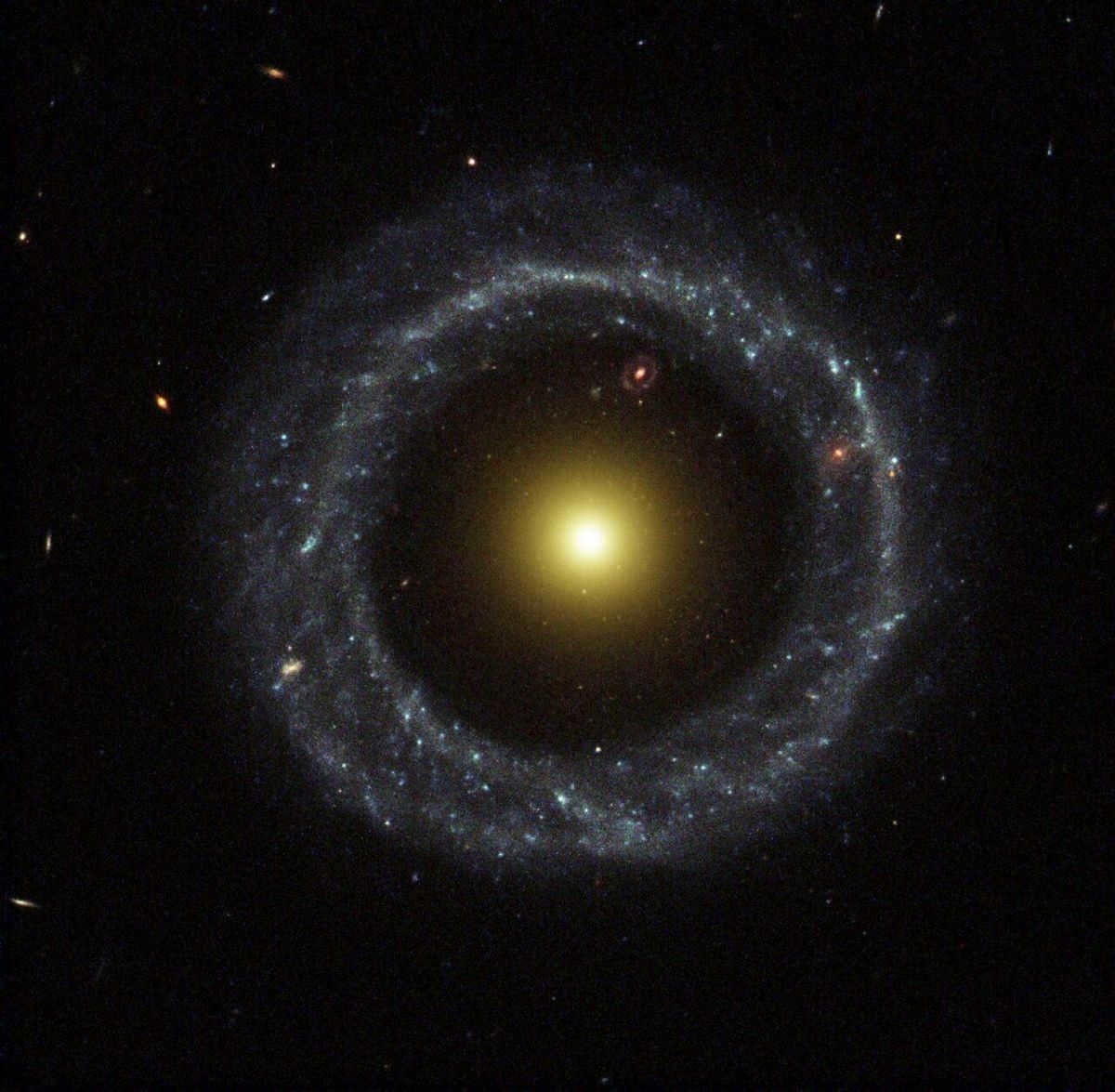

The de Vaucouleurs classification scheme for galaxies
Scientists commonly utilize the de Vaucouleurs classification system when studying celestial bodies and entities.
This classification system is an expanded and revised version of the Hubble and Yerkes classification schemes. It categorizes galaxies based on their shape spectra and their level of concentration towards the central region.
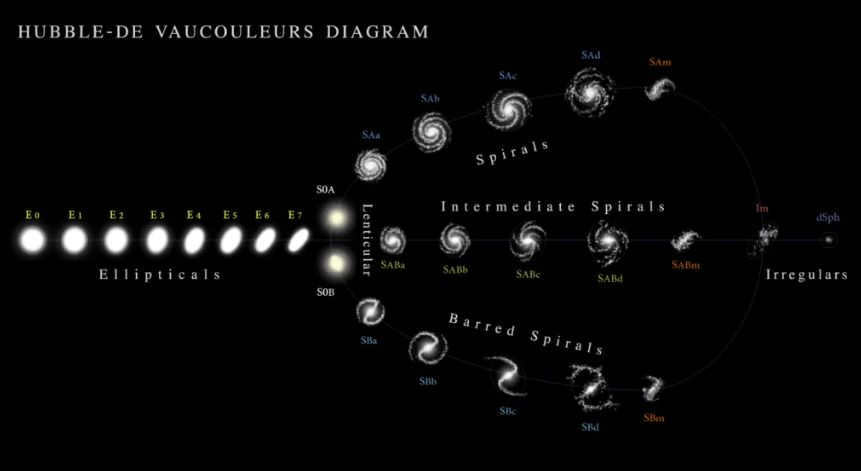
Peculiar galaxy
A peculiar galaxy is an object that cannot be categorized within the Hubble system. These galaxies possess distinctive individual characteristics.
What sets them apart from irregular galaxies is the presence of specific criteria for these characteristics. Astronomers are able to fully describe the unique traits of each peculiar galaxy.
The name for these objects is derived from the English word “peculiar,” which means “unusual.”
Some scientists actively argue against the classification of galaxies into this type. They believe that the term “peculiar galaxy” does not exist and that these objects should be assigned to other categories. Opinions on this matter vary, and even modern astronomers are unable to reach a unanimous decision.
Peculiar galaxies often exhibit a distinct variation in their structure, with noticeable distortions and frequently observed dust streaks and substance emissions.
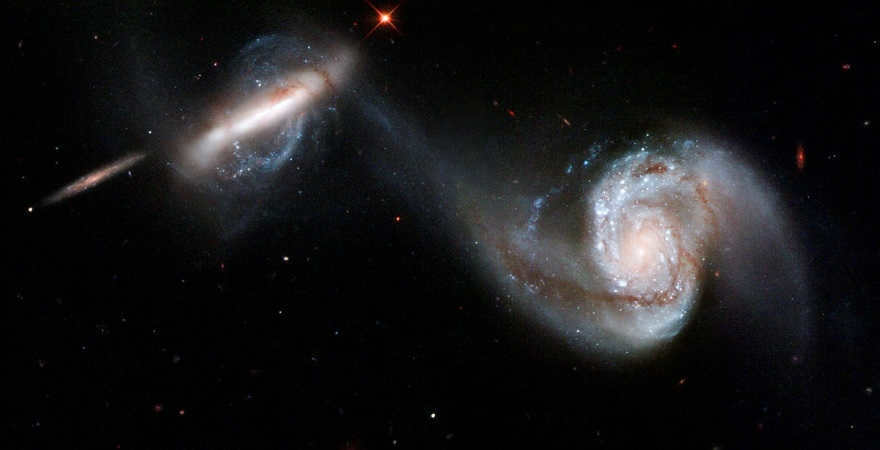
The Formation Process of Galaxies
The query concerning the precise formation of galaxies is a matter of great interest for many curious individuals. Even scientists themselves sometimes struggle to reach a consensus on the creation of specific celestial bodies. Nonetheless, several hypotheses have garnered considerable evidence, suggesting their proximity to the truth.
To comprehend the historical development of galaxies, one must journey back millions of years. Initially, a significant cosmic explosion occurred, resulting in the formation of a vast expanse of space. Within a matter of minutes, this space became filled with a variety of matter clumps. The distribution was not uniform, and as a result, distinct regions with a considerable concentration of matter began to form.
Once the universe had cooled down, gravity began to exert its influence. Similar to a magnet, it attracted fresh matter to the existing clusters. In regions where the clusters were sizable enough, the very first stars came into existence, casting light upon the cosmos. Within each such cluster of matter, countless stars were born.
It remains uncertain whether galaxies were initially formed in their present state or if the clusters underwent constant modification and amalgamation, resulting in the formation of relatively large galaxies.
Galaxies predominantly consist of dark matter, which interweaves the universe like a spider’s web. Numerous scientists posit that there is a significantly greater amount of this matter than commonly believed, as it has had a profound impact on the development of galaxies.
Scientists claim that creating a comprehensive depiction of the Universe is an unattainable feat. There remain numerous uncharted territories that astronomers have yet to fully grasp.
At present, individuals are limited to solely mathematical and visual evidence when it comes to understanding space and the vastness of the Universe. It is inconceivable to fathom their true dimensions, even in an approximate sense.
The galaxies and celestial entities perceived by astronomers via a telescope are merely the remnants of light that has reached Earth after billions of years. It is entirely plausible to speculate that the current state of cosmic objects is vastly different from what is currently perceived.
In the future, it is highly likely that our galaxy will assimilate another dwarf galaxy or, conversely, be assimilated by a larger entity. Despite humans’ active exploration of galaxies and the Universe, it is improbable that they will personally witness this cataclysmic event. If such an event does transpire, it will occur more than three billion Earth years from now. It remains uncertain whether life will endure on Earth during that time period.
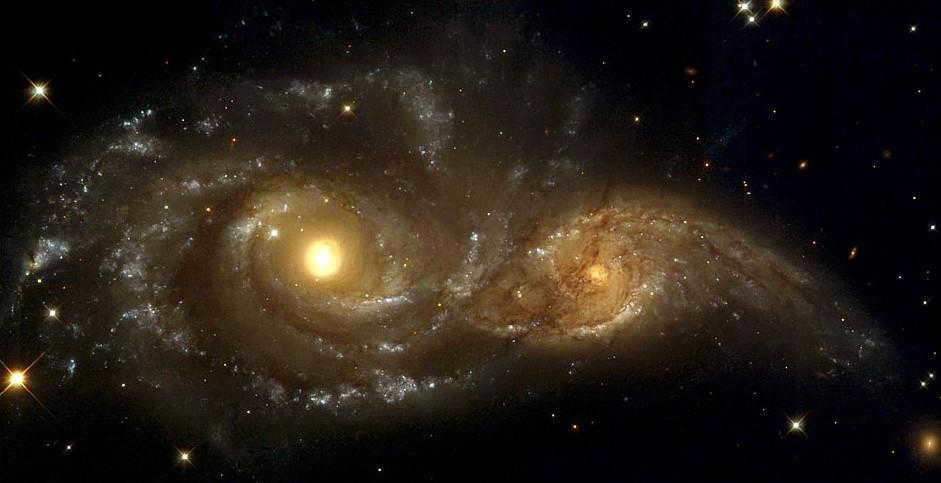
What is the total number of galaxies in the Universe?
The precise number of galaxies in the Universe remains unknown. Scientists can only provide approximate estimates.
In 1990, astronomers identified approximately 100 billion galaxies based on the Hubble classification.
However, in 2016, a revision of this figure took place. At that time, experts managed to discover and identify around two trillion objects. It is possible that as technology advances in the future, people may be able to detect hundreds of thousands of additional galaxies.

During my time at two major mobile network providers, I gained valuable experience in the cellular communication industry. This experience has given me a deep understanding of different tariff plans and the ability to navigate through potential pitfalls. Furthermore, I have a passion for gadgets, with a particular affinity for Android devices.

Even with the use of advanced technology, scientists still face challenges in accurately identifying all the various types of galaxies that exist in the Universe.

Every single minute, the universe is in a perpetual state of flux. There is never a moment when all objects and galaxies remain static. It is a constant dance of transformation and evolution. However, observing and documenting these changes can be quite challenging. The light that reaches our telescopes is merely a snapshot of what has occurred in the distant past, after traveling through vast distances and time.

Indeed, with professional equipment, it is possible to observe various types of galaxies. Ordinary telescopes do not have the necessary capabilities to provide accurate results.
In the year 1936, Edwin Hubble proposed a classification system for galaxy evolution that is still widely accepted today, with only minor modifications. According to this system, there are four main categories of galaxies. Occasionally, dwarf galaxies are regarded as a distinct category, but they are not differentiated by any unique characteristics apart from their relatively small size and therefore can be classified within one of the traditional types.
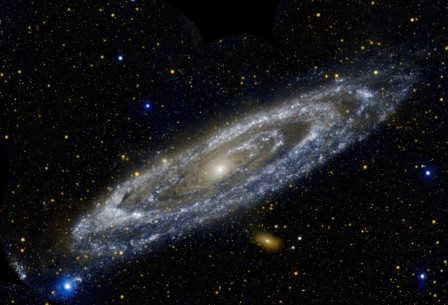
Andromeda Galaxy
©GALEX, JPL-Caltech, NASA
Elliptical galaxy
At first glance, it appears to be a massive celestial body – a radiant sphere with its strongest luminosity concentrated in the center and gradually diminishing towards the periphery. Elliptical or spheroidal galaxies primarily consist of aging stars, resulting in their distinctive yellow or reddish tint. The formation of new stars is extremely rare within these galaxies, given the minimal presence of interstellar gases and dust particles (although there are occasional exceptions). The distinguishing features among elliptical stellar systems lie in their size and level of compression, which are used to classify them from E0 to E7. These galaxies account for approximately 25% of the observable galactic population. According to Hubble’s classification, they represent the initial phase of galactic evolution.
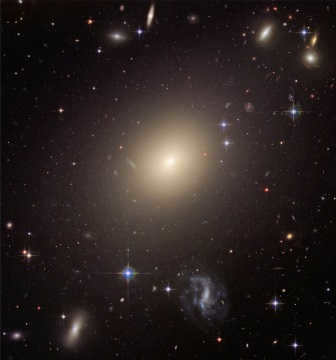
ESO 325-G004 is an example of an elliptical galaxy.
Spiral galaxy
Spiral galaxies are the most prevalent and visually stunning type, comprising over half of all known galaxies. They resemble disks with a luminous yellow nucleus, surrounded by delicate bluish spiral arms (which are formed by the presence of unique stars such as white and blue supergiants).
Spiral galaxies differ from elliptical star systems in several structural features. Firstly, they have arms where active star formation processes occur. Secondly, there is a stellar disk – a relatively thin layer of matter along the galaxy’s plane, where the majority of the system’s objects are located, and the stars within it orbit around the center of the disk. Thirdly, the presence of interstellar gas and dust, which is necessary for the formation of stars, is commonly observed. Many spiral galaxies have a bar-like structure at their center, from which the arms diverge. They are classified with the letter S and vary in the density of their arms (Sa-Sd, with a bar – SBa-SBd).
The average number of arms is a couple, although there may be more arms present in some cases. In certain instances, these arms can vary in size. With the exception of experiencing a galactic collision, all of these arms are twisted in one direction around the center. The center itself contains the majority of the matter, which is concentrated in the form of a supermassive black hole and a dense spherical cluster of old stars known as the bulge.
Both the Milky Way, our own galaxy, and the Andromeda Nebula, which we will inevitably encounter in 4 billion years, are spiral galaxies. The Sun is situated between the arms and is located away from the galactic center. Its speed is approximately equal to the rotation speed of the arms. This allows the solar system to avoid regions of active star formation, which can be dangerous to Earth life due to frequent supernova eruptions.
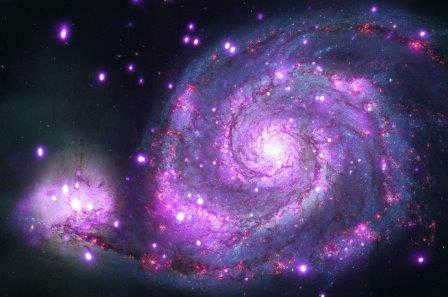
The Whirlpool spiral galaxy and its companion NGC 5195
©NASA
Galaxy of the lenticular type
According to the Hubble classification, lenticular galaxies are an intermediate type between elliptical and spiral galaxies (S0). These star systems have a stellar disk surrounding a central globular cluster-bulge, but the arms are relatively small and less pronounced, and there is insufficient interstellar gas and dust matter for active star formation. The dominant population consists of old, large stars that are red or yellow in color.
Lenticular galaxies differ in the amount of interstellar dust and the density of the central bulge. They make up approximately 20% of the total number of galaxies.
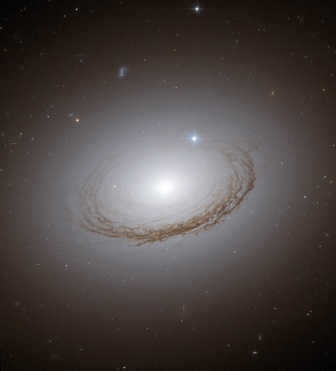
The lenticular galaxy NGC 7049
©NASA/ESA
Different type of galaxy
Irregular galaxies do not have the typical shapes of elliptical or spiral galaxies. Instead, they are gravitational clusters of stars that are often without a defined shape or center. These galaxies make up approximately 5% of the total number of galaxies in the universe.
What sets irregular galaxies apart from other types? It is highly likely that each of these star systems was once an elliptical or spiral galaxy, but was altered due to a collision with another galaxy or close proximity to one.
There are two primary classifications of irregular galaxies: those that possess some sort of structure that allows them to be categorized according to the Hubble sequence (Irr I), and those that lack any semblance of structure (Irr II).
Occasionally, a third category, known as dwarf irregular galaxies (dl or dIrr), is recognized. These galaxies contain low levels of heavy elements and significant amounts of interstellar gas, making them reminiscent of the protogalaxies that existed in the early Universe. Therefore, studying these irregular galaxies is crucial for comprehending the process of galactic evolution.
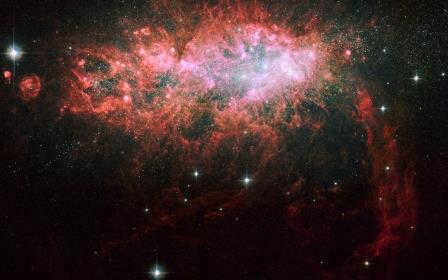
NGC 1569, situated in the constellation Giraffe, is a small irregular galaxy. It is known for its unique features and has been extensively studied by astronomers. The image of NGC 1569 was captured by NASA/ESA and showcases the galaxy’s breathtaking beauty.
More on NGC 1569:
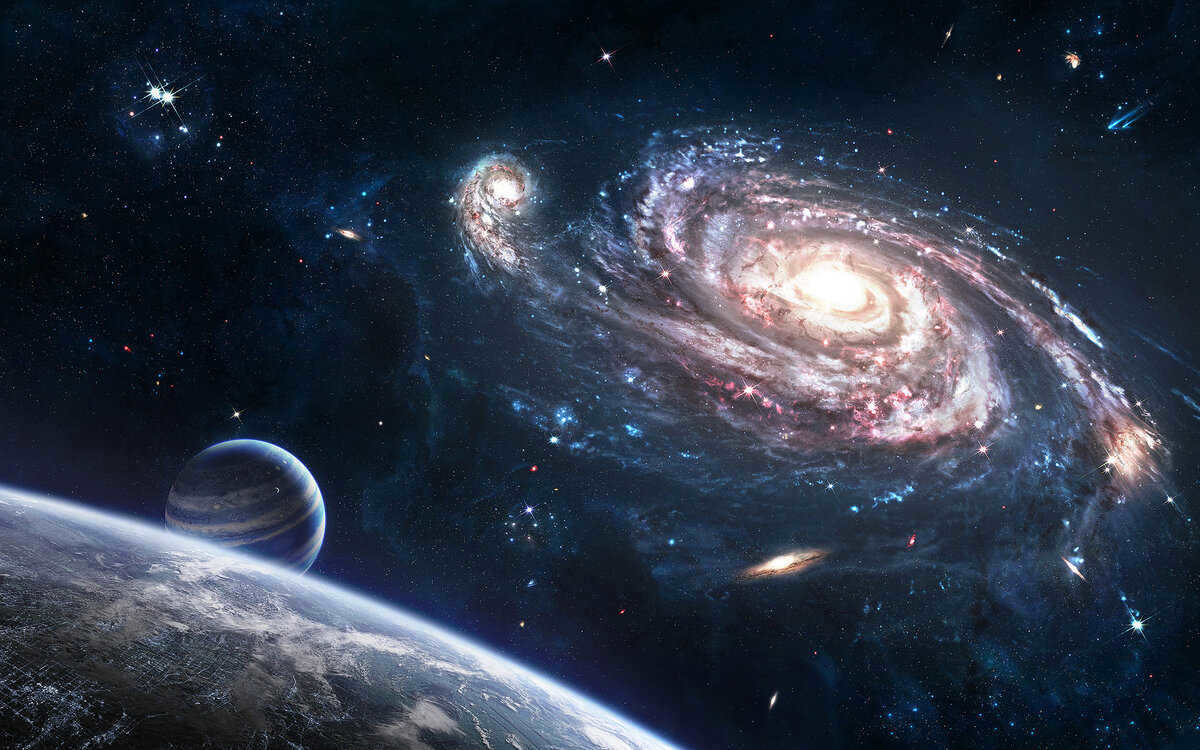
In the vast expanse of the observable universe, galaxies are abundant. These immense conglomerations consist of stars, gas, dust, planets, rocks, and even dark matter. The sheer magnitude of these galactic formations is truly awe-inspiring, with estimates suggesting that there may be as many as 200 billion galaxies in total. It is truly a sight to behold, and with the aid of a telescope, one can witness the incredible diversity that exists among these cosmic wonders.
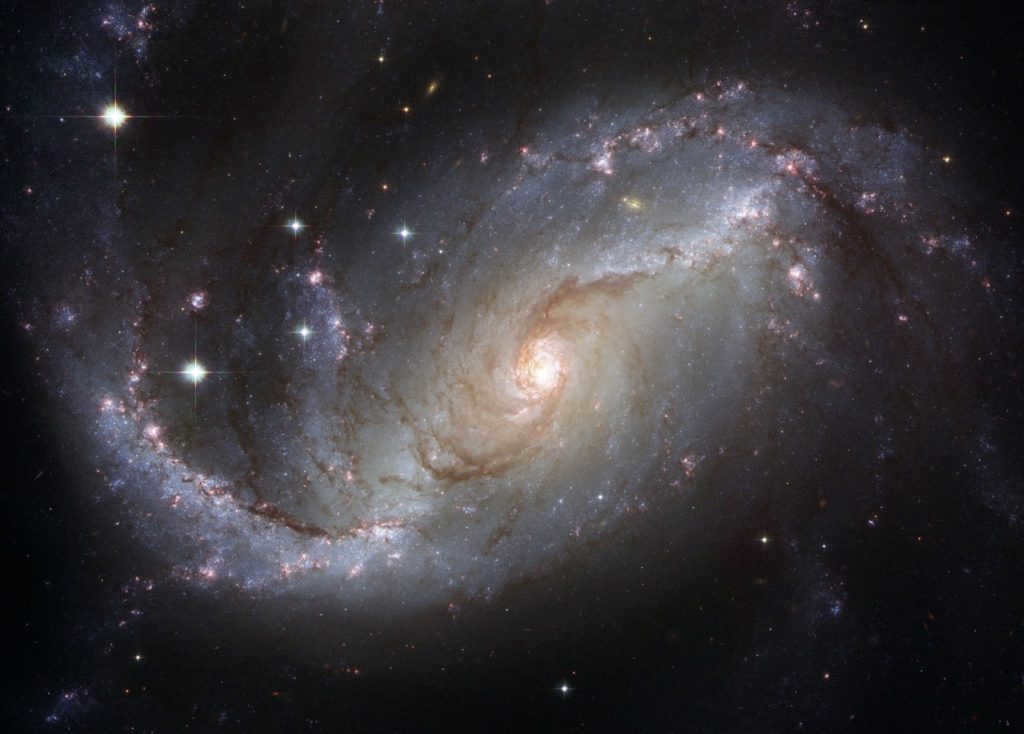
Galaxy Varieties
In the world of astronomy, galaxies are typically grouped into three primary classifications: elliptical, spiral, and irregular.
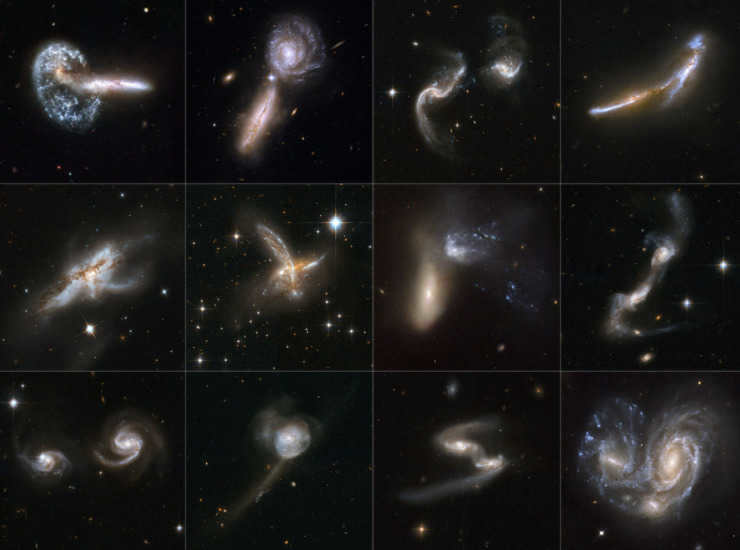
There is a great diversity of galaxies in terms of size. They can range from small dwarf galaxies, which have a population of up to 100 million stars, to massive ones that contain over a trillion stars.
The Milky Way, our own galaxy, is classified as a spiral galaxy.
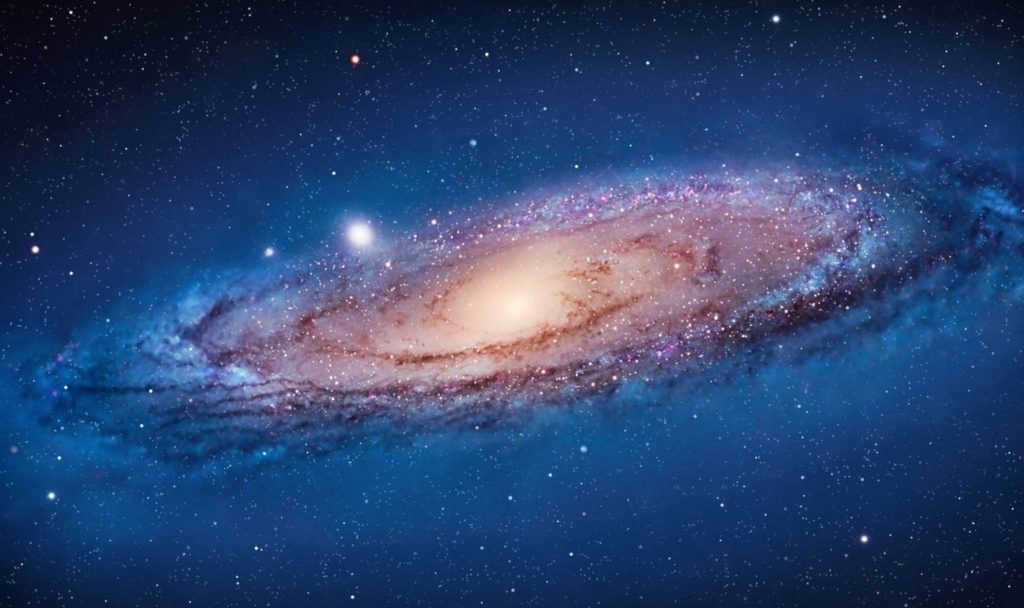
Aside from these three, there exist other forms. Galaxies typically exist in groupings like clusters and filaments that are divided by vast empty spaces, creating a grand structure known as the Cosmic Web.
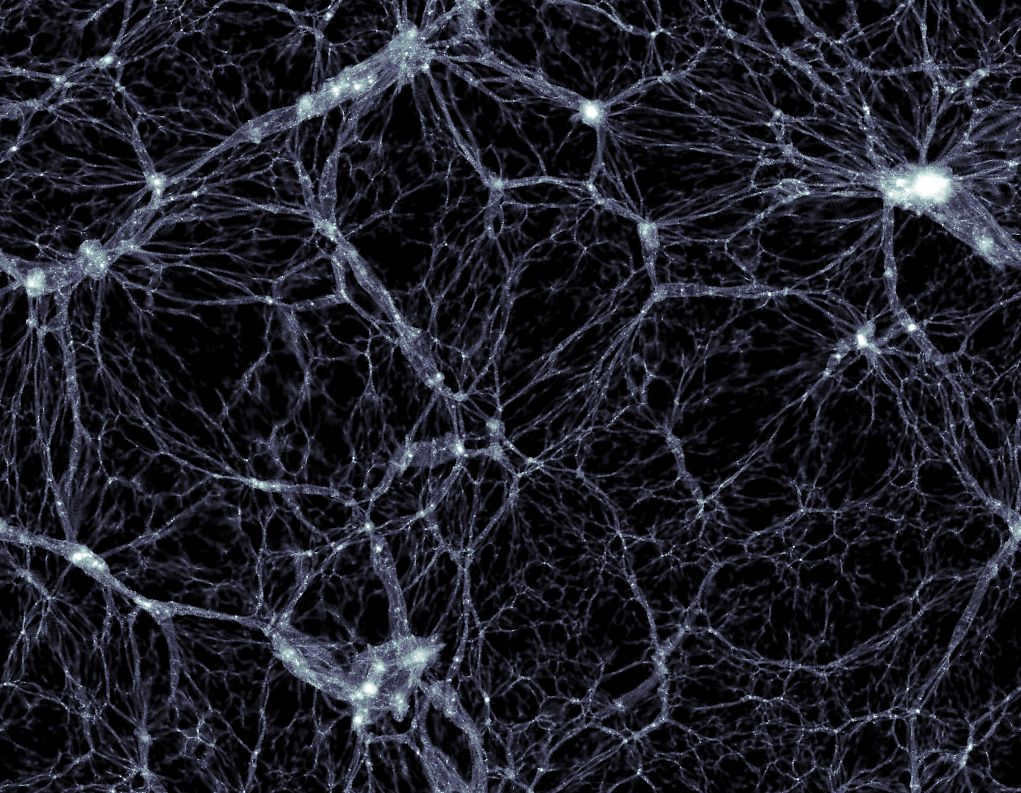
A table depicting the distinguishing features of different types of galaxies:

Practically every significant extraterrestrial race possesses supermassive black holes situated at the core of their respective galaxies, which exert a significant influence on the development of their galactic homes.
Spiral
A common form of a galaxy consists of a disk accompanied by a central bulge.
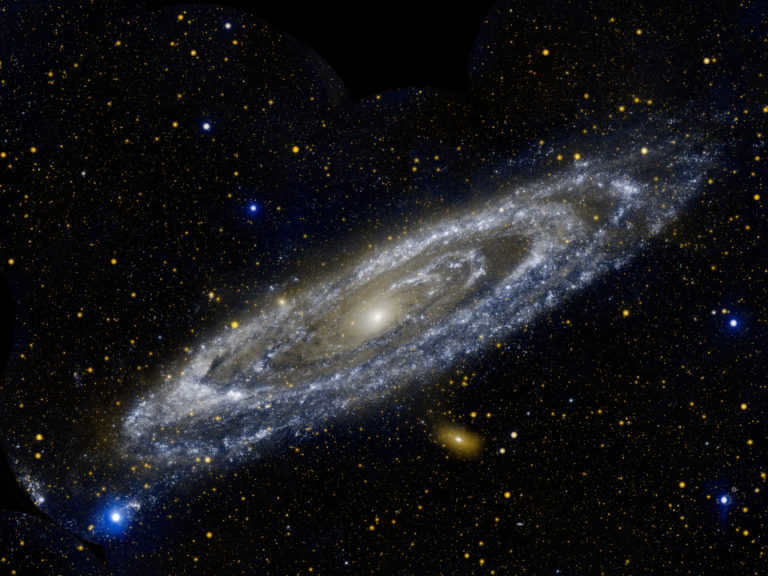
The galaxy is usually around 100,000 light-years wide and has a thickness of approximately 1,000 light-years. It is recognized by its diminishing brightness from the center outwards, forming a spiral or columnar design, or sometimes both.
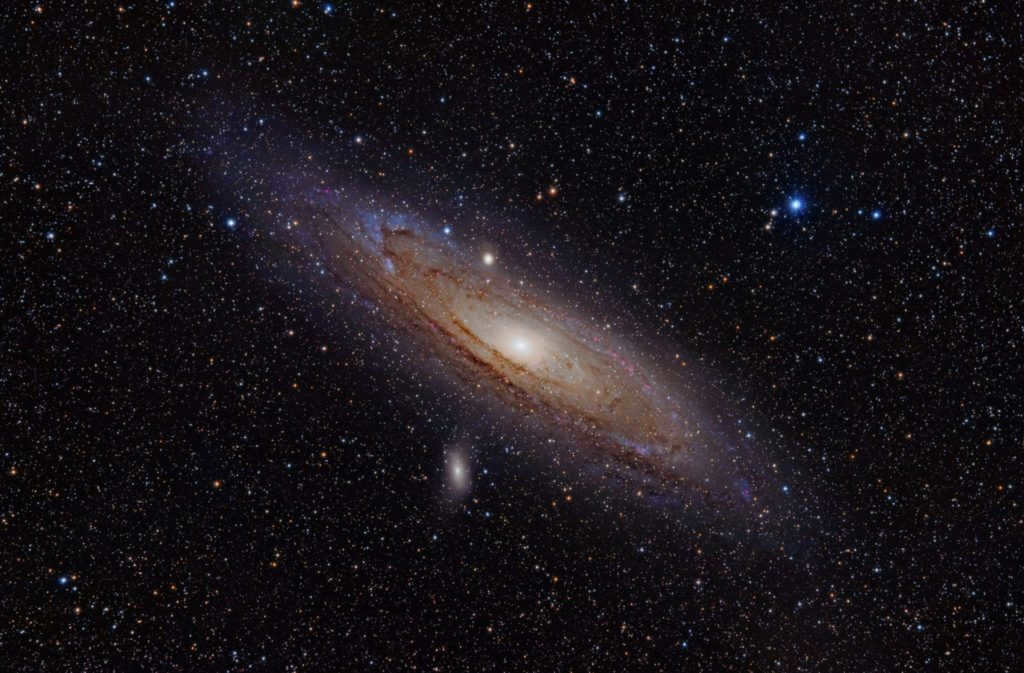
Galaxies that possess a central bulge can have varying sizes, ranging from hundreds to thousands of light-years in diameter. These types of galaxies are categorized as spiral (S) and can be further classified into subclasses a b or c (e.g., Sa) to indicate the level of openness of their spiral structure and the relative smallness of the bulge.
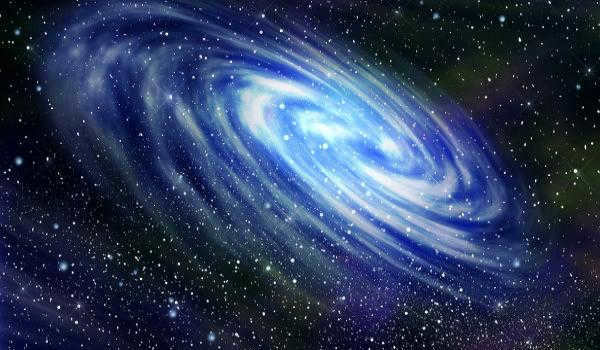
The galaxies’ disks are primarily composed of Population I stars, with their bulges consisting mainly of Population II stars. The Sb type is the classification for the Milky Way.
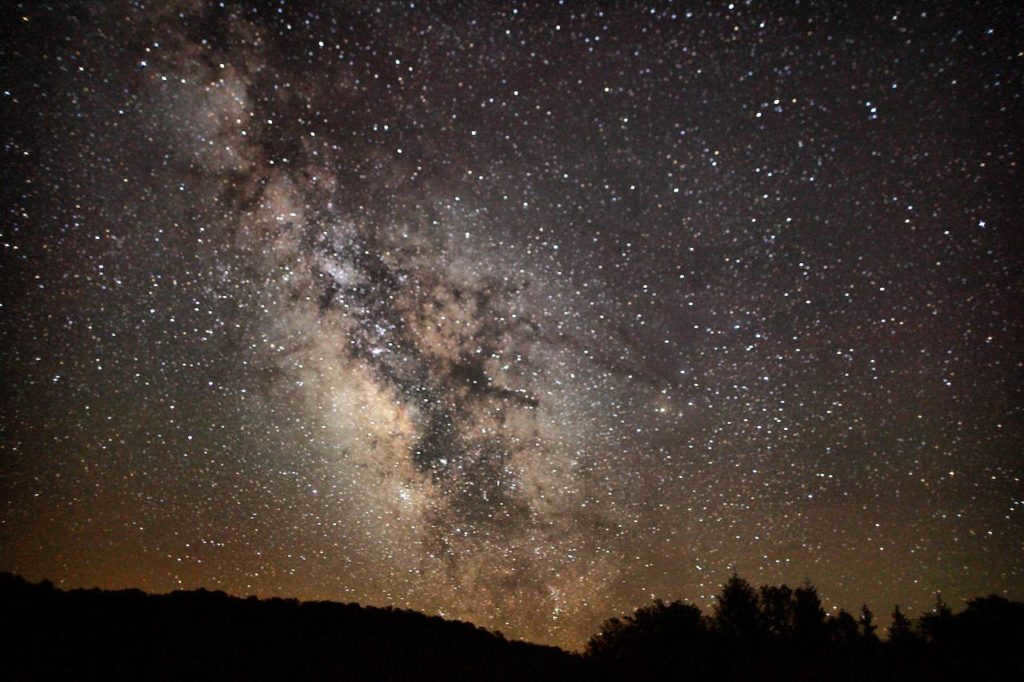
There is a nearly linear feature in the central regions of numerous spiral and irregular galaxies.
These objects, known as barred galaxies, can otherwise be classified into the various types of galaxies.
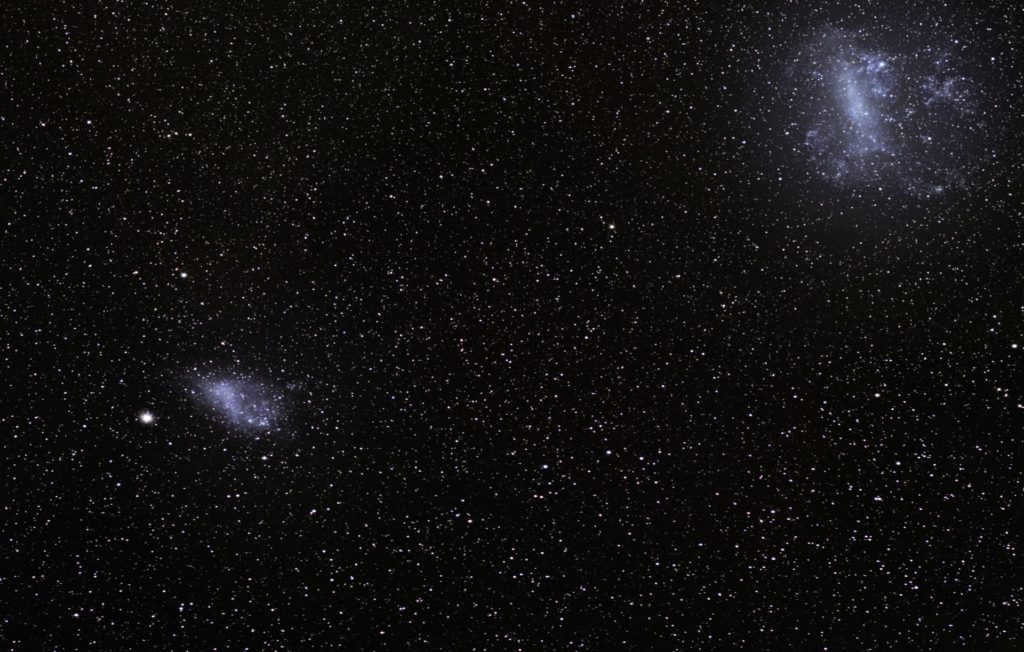
The classification of spiral galaxies that have prominent barred objects includes the addition of the letter B after S (for example, M61 is classified as an SBC). It can be assumed that the majority of spiral galaxies have a small number of stars orbiting in bar formations.
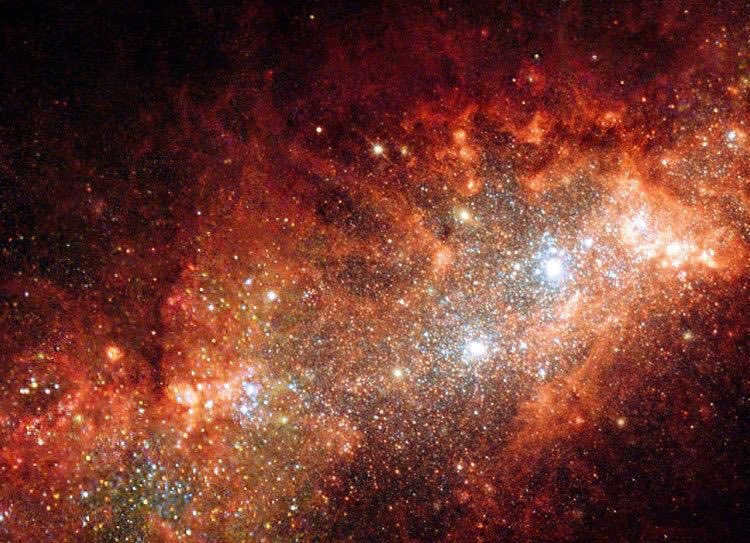
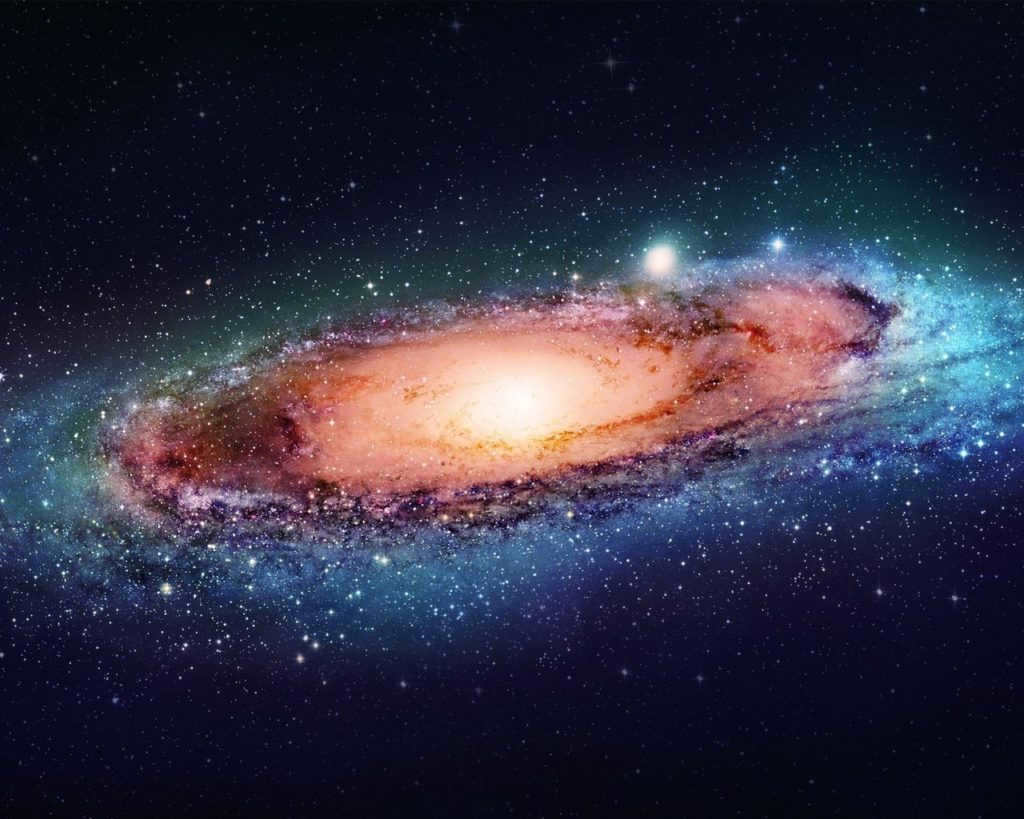
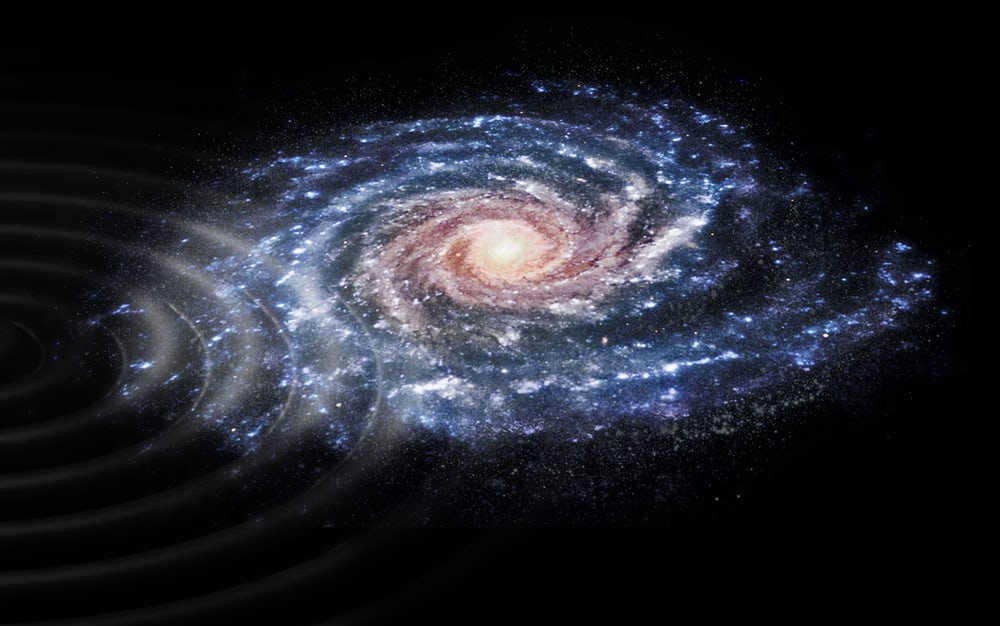
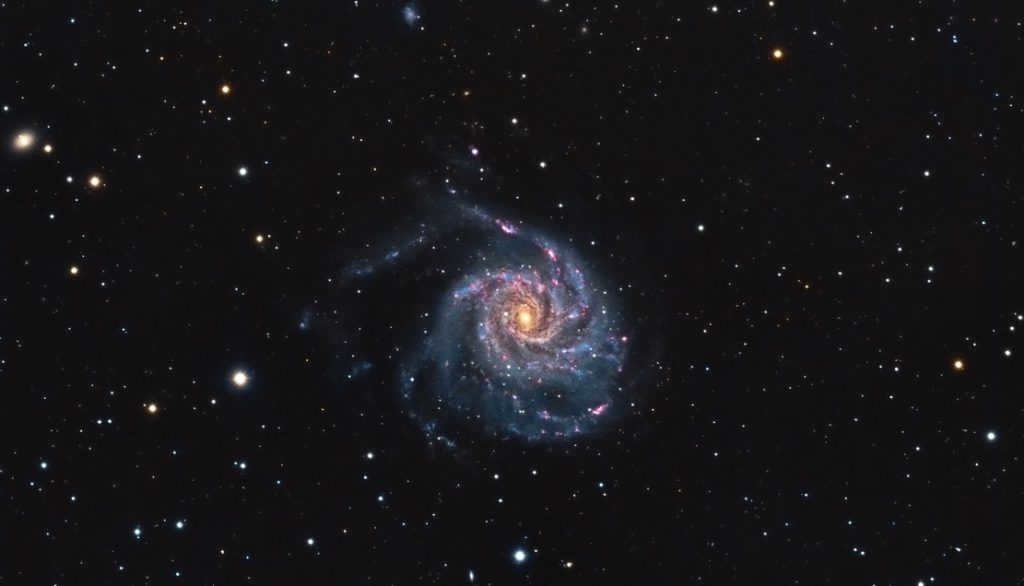
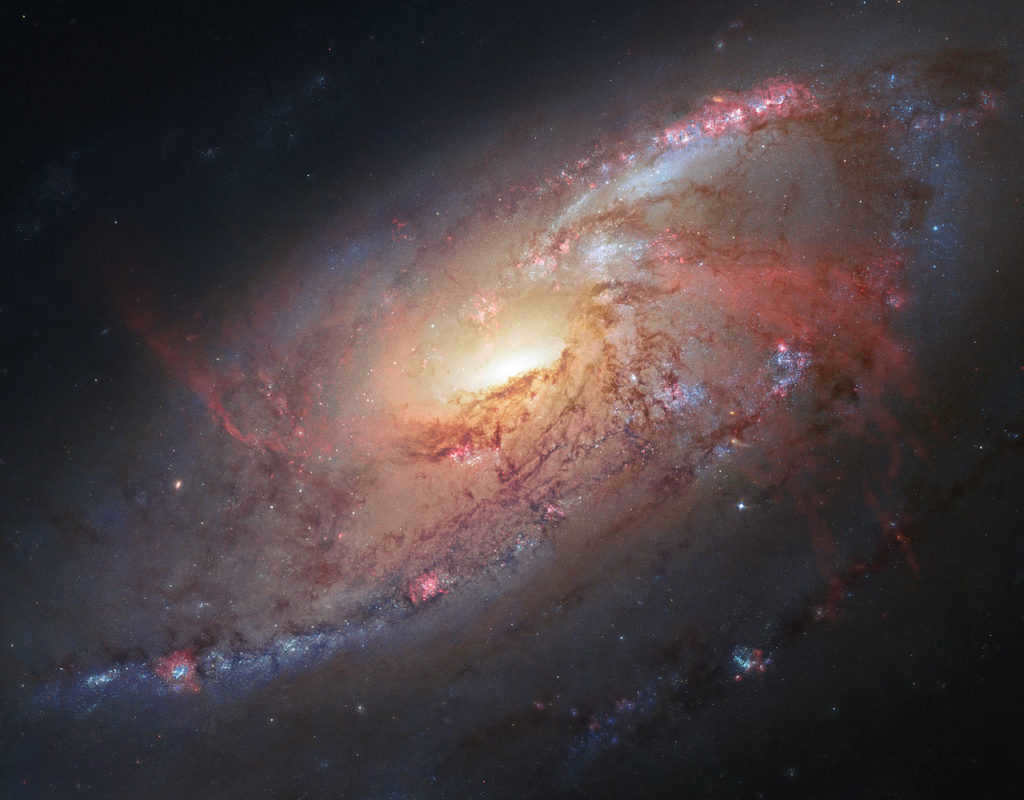
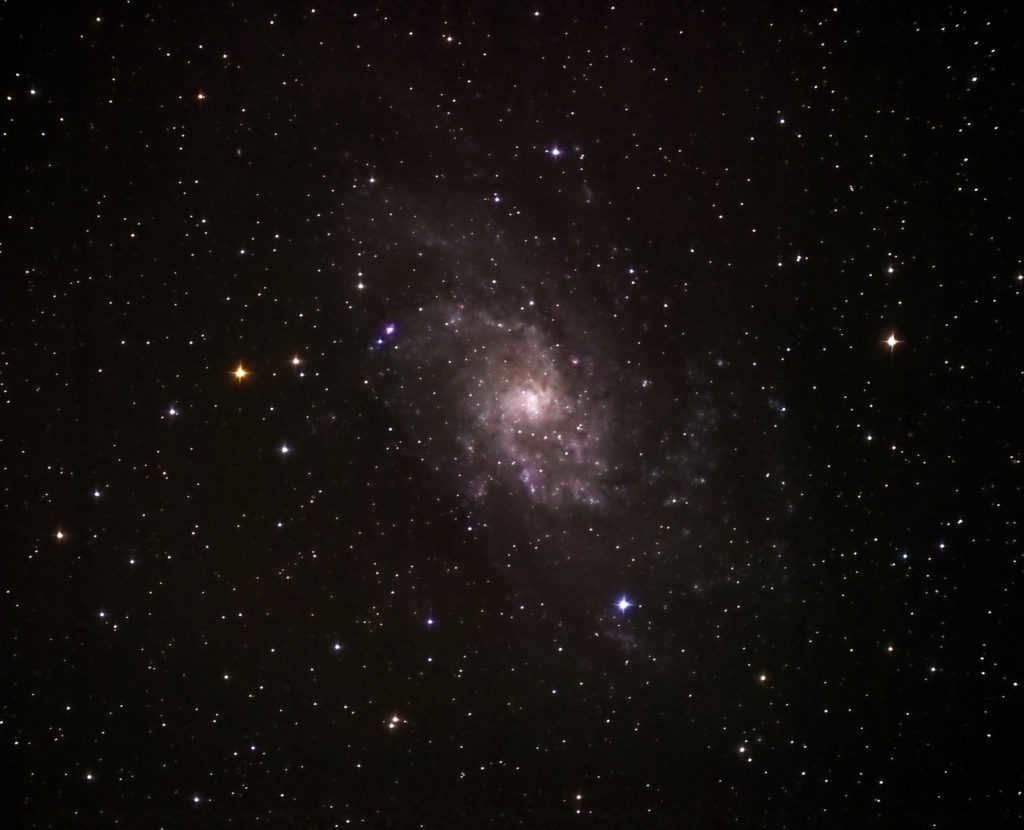
Elliptical Galaxies
An ellipsoidal shape with decreasing brightness is a characteristic feature of another widely observed type of galaxy.
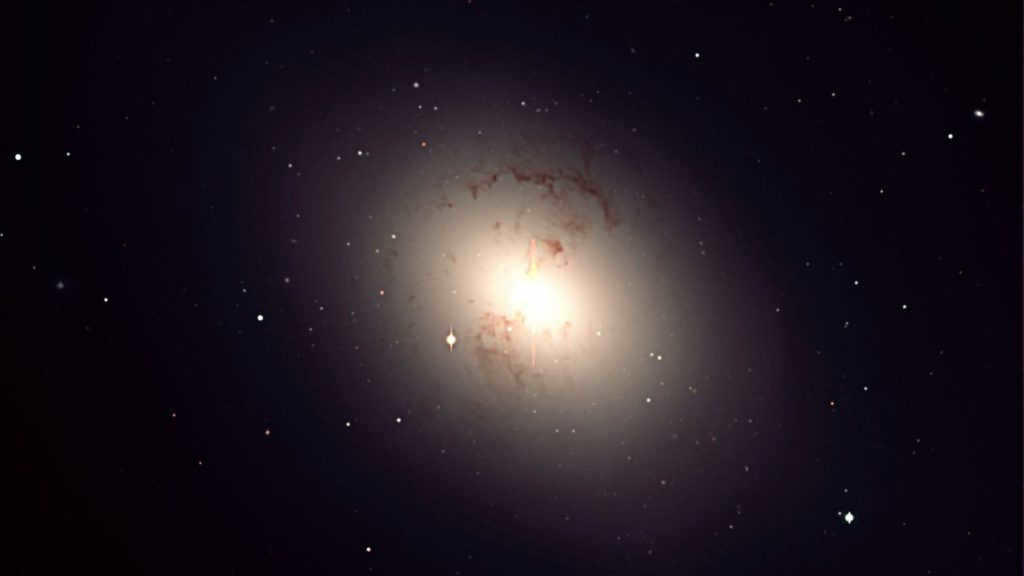
The types of galaxies that exist are known as elliptical (E) and are categorized based on their axial ratios, ranging from 0 (E0 = circular) to 7 (E7 = axial ratio of 3 to 1). Furthermore, elliptical galaxies are further divided into subclasses based on the contours of constant brightness in images, which are referred to as isophotes.
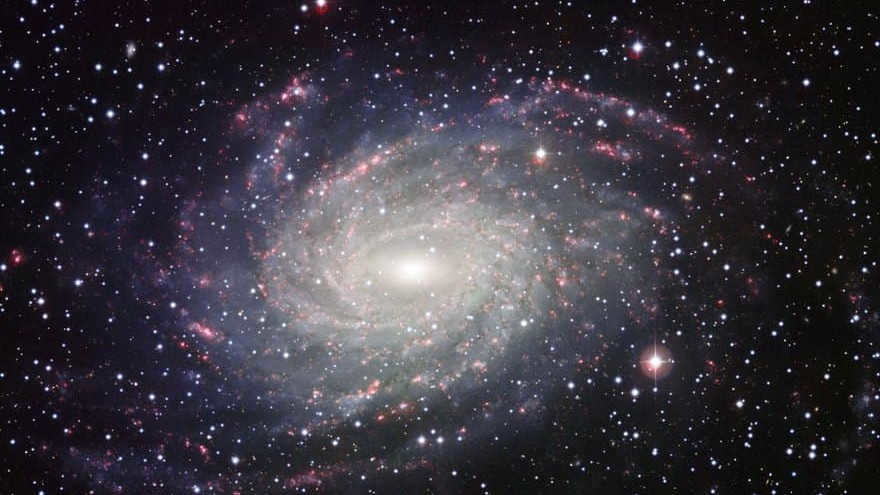
E-type galaxies exhibit box-shaped isophotes, whereas galaxies of the E variety with lower brightness display isophotes in the form of disks. The size of elliptical shapes can vary from several thousand to hundreds of thousands of light-years in diameter.
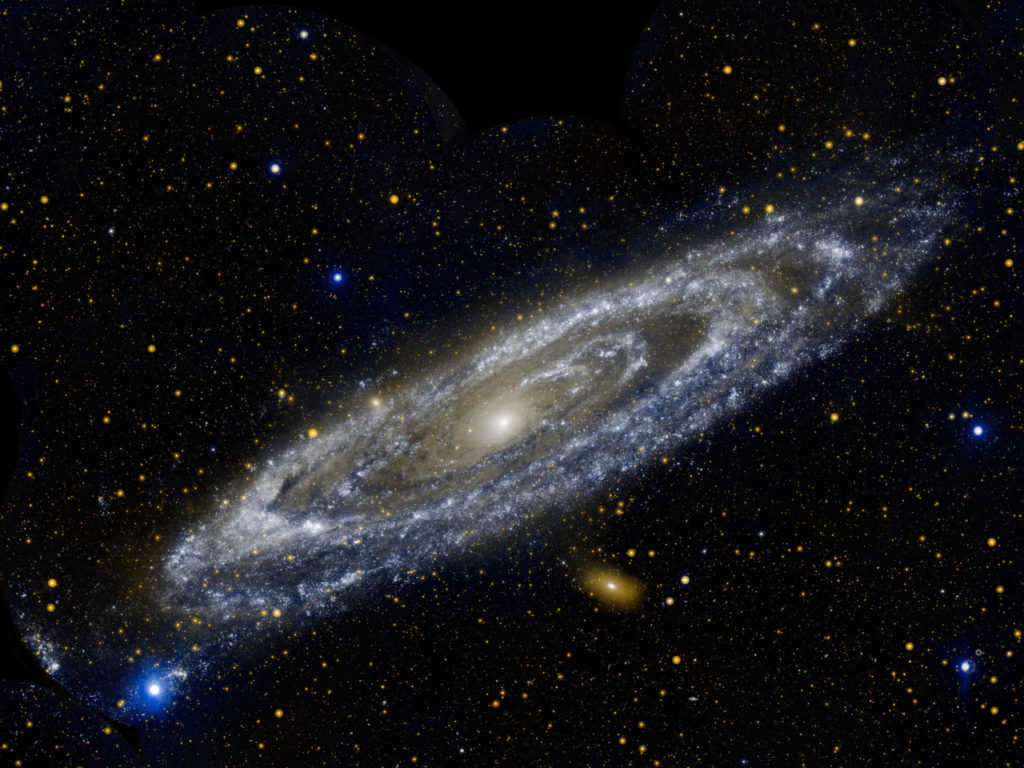
Galaxy clusters are the primary habitats of these celestial objects, which are characterized by a halo of hot gas and, in approximately 50% of instances, a discernible presence of dust. The most luminous varieties typically exhibit an elliptical morphology.
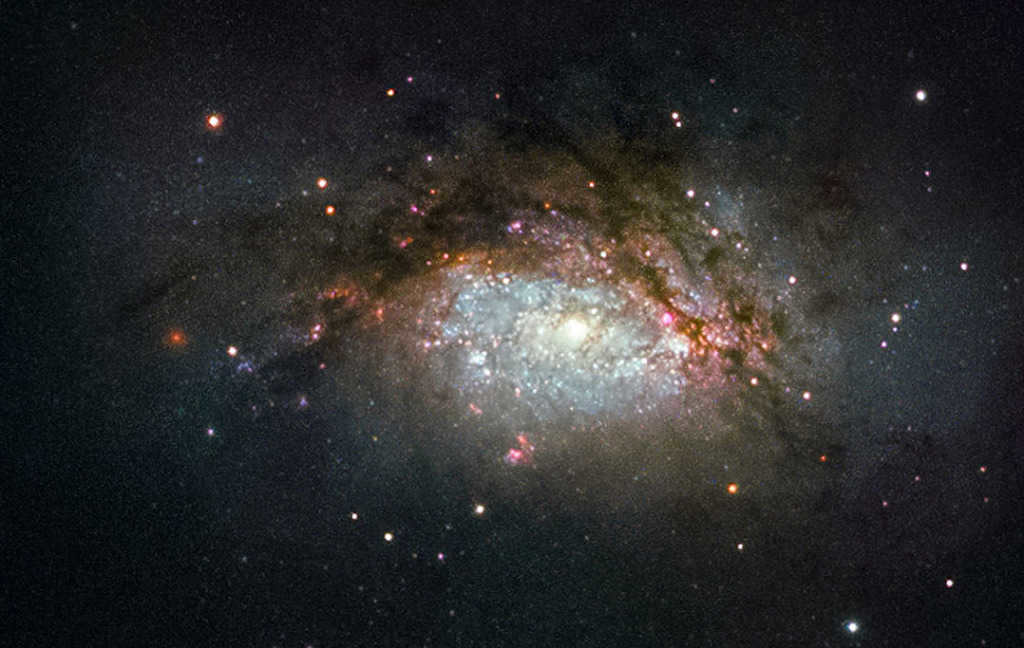
The types of galaxies that exist are primarily populated by population II stars, which include:
- M87 (NGC 4486), which was the first supermassive black hole to be imaged by the Event Horizon telescope;
- M89;
- M105 (NGC 3379);
- IC 1101, one of the largest galaxies in the observable universe;
- Maffei 1, the closest giant elliptical galaxy;
- CG 049-033, known for discovering the longest galactic jet;
- Centaurus A (NGC 5128), an elliptical/lens-shaped radio galaxy with unique morphology and unusual dust streaks;
- Neve 1, the source of the eruption of the Serpentine supergroup, the most powerful known astronomical event.
Distinctive
Less common variations incorporate a transitional group known as S0, which exhibits a disk overlaid on an elliptical form of light distribution, and the atypical (Irr) group, consisting of galaxies with disordered structures and typically low total brightness.
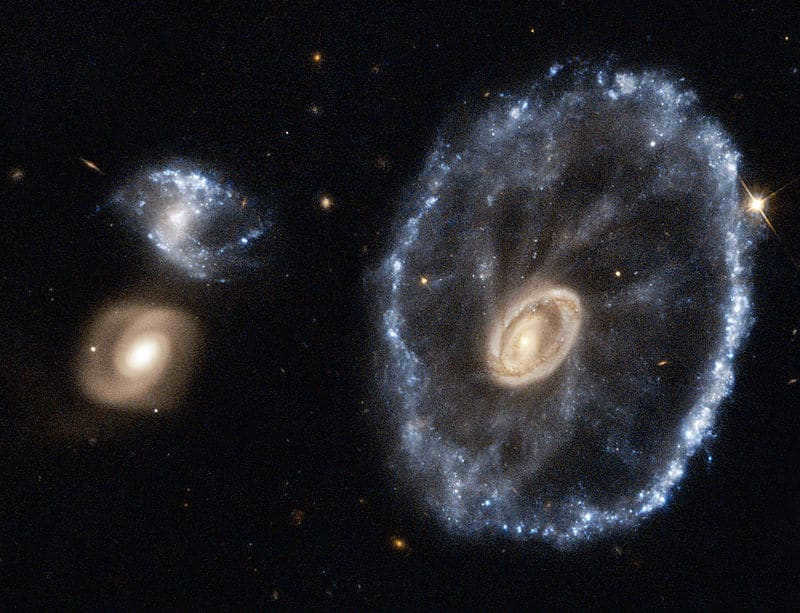
There are certain shapes that appear to be spiral galaxies of small size, but their regular forms have been altered by gravitational interactions with other galaxies. The Small Magellanic Cloud, which is categorized as a dwarf irregular galaxy, most likely no longer retains its original spiral shape due to disturbances caused by its larger counterpart, the Milky Way.
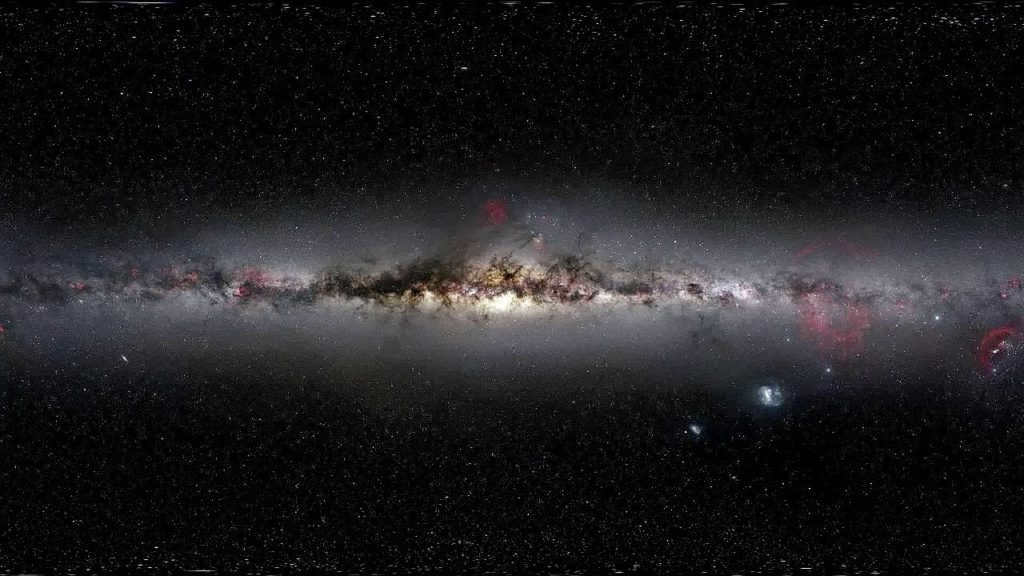
Unconventional categories
Certain categories exist beyond the typical scope of morphology. The majority of these galaxies have undergone some form of disruptive incident, such as a gravitational collision, fusion, or intense nuclear activity.
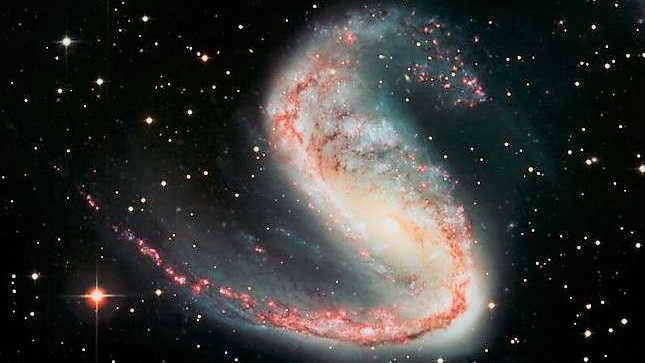
Others seem to have originated as peculiar incidents, which encompass galaxies with low luminosity:
- Starbursts. One of the most remarkable instances of extraordinary forms are the galaxies that generate stars. These galaxies have an abnormally high rate of star production. It is currently acknowledged that in the majority of cases, the atypical star formation activity was triggered by a gravitational impulse of some kind. The explosion is a transient condition, and the galaxies that are currently undergoing explosions must have spent the majority of their existence in a calmer state.
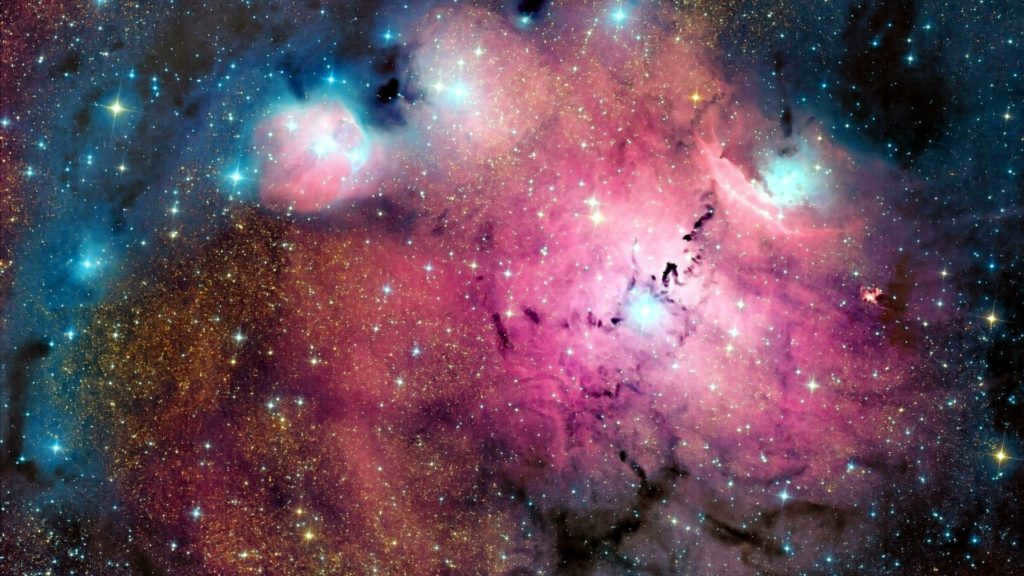
- What types of galaxies exist?
- One more kind of galaxy is a galaxy with a low surface brightness, which is almost impossible to see due to its low density of stars. Sculptor dwarfs have many similarities to globular star clusters (very old stars, variable stars in clusters, and an even distribution of stars), but they are much less dense and are dominated by dark matter. Other galaxies have a mixture of different types of stars. For instance, the dwarf galaxy Carina experienced at least two episodes of star formation, approximately 13 and 7 billion years ago. There are also extremely irregular and spiral galaxies that have certain structural characteristics, but they are so dim that they are hard to detect against the brightness of the sky. It is possible that a significant portion of the universe’s mass exists in these almost invisible galaxies.


Research on the movement of celestial bodies conducted by specialists
Experts have conducted extensive studies on the internal motions of stars and interstellar matter. They have discovered that these celestial bodies revolve around a central point known as the center of mass. This center of mass is often characterized by a bright nucleus. In galaxies with a spiral shape like our own Milky Way, there are typically two distinct types of stellar orbits.
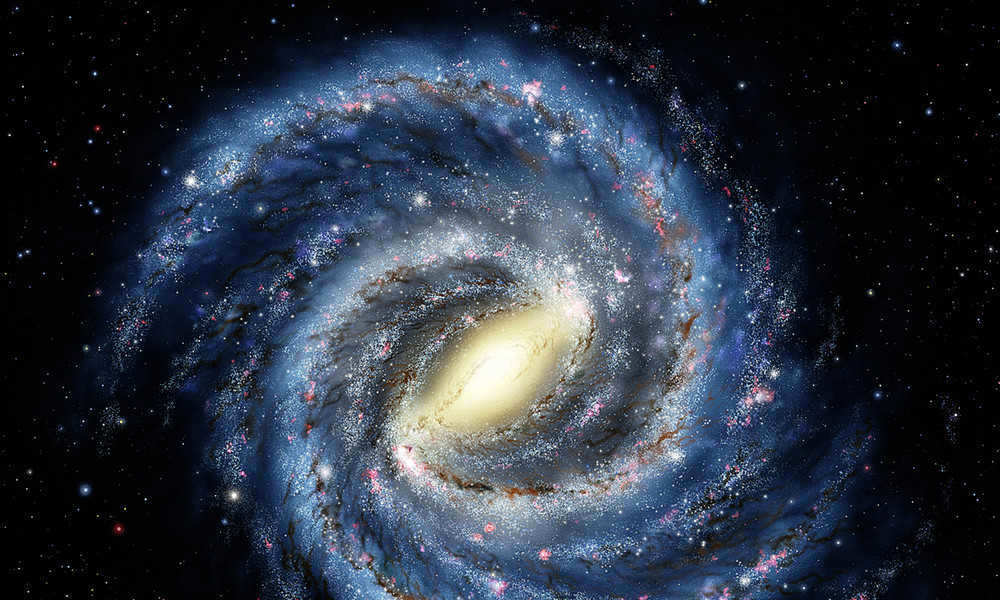
Galaxies come in various forms and sizes. Some galaxies have a flat structure, with stars moving in nearly circular orbits, while others have a more spherical shape, with stars following highly elliptical orbits in the bulge and halo regions.
The gravitational field of the galaxy influences the motion of stars, causing them to react and move in different ways.
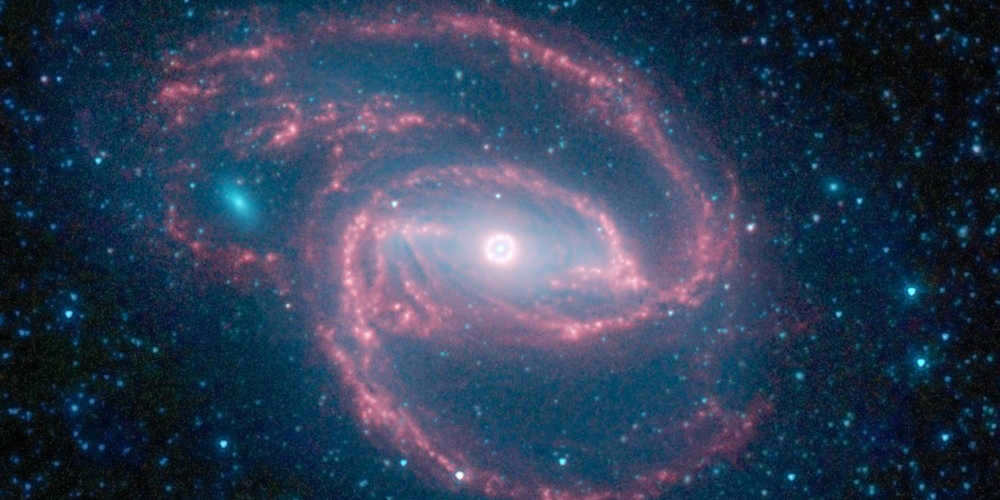
Galactic motions serve as a safeguard against gravitational collapse, similar to how the planets in our solar system remain in orbit around the Sun. Generally, the central areas of a spiral galaxy rotate in a manner akin to a solid body (velocity increases with radius), while the outer regions experience differential rotation (constant velocity).

The velocities of matter within galaxies can range from a few to several hundred kilometers per second. Stars typically have orbital periods of several hundred million years. The distribution of kinetic energy in randomly oriented and circular rotational motions is dependent on the specific type of galaxy.
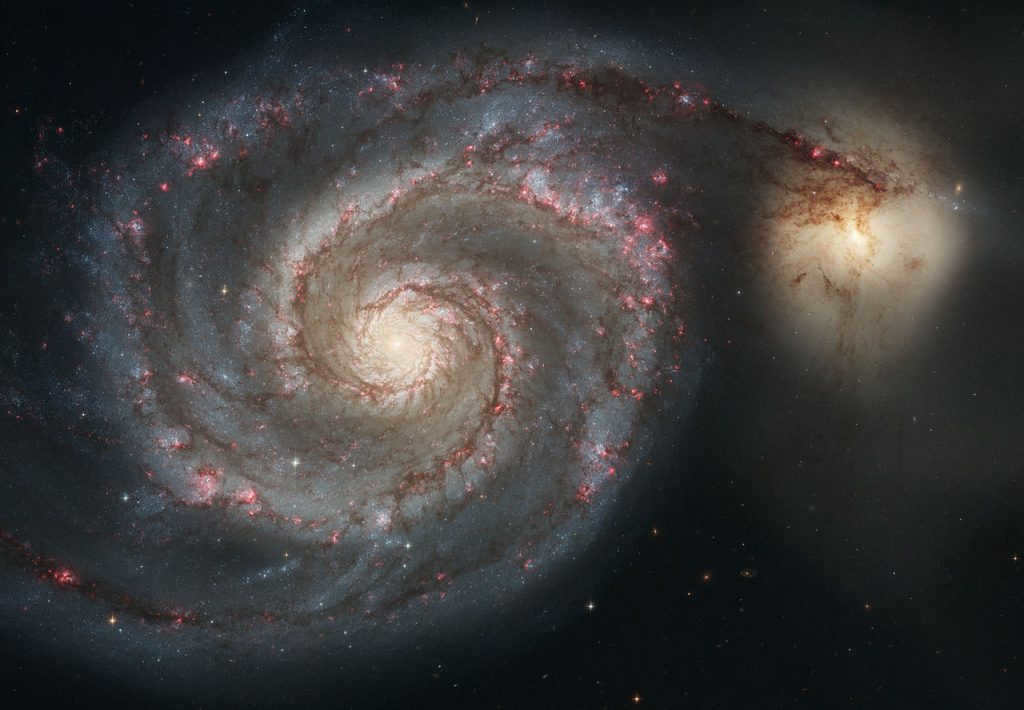
Random motions make up only about 1% of the total kinetic energy of a spiral-shaped disk, whereas square E galaxies, in contrast to disk-shaped galaxies, tend to have a larger proportion of their energy in random movements. The release of energy that fuels all these varied phenomena occurs when matter enters the supermassive black hole located at the core of galaxies.
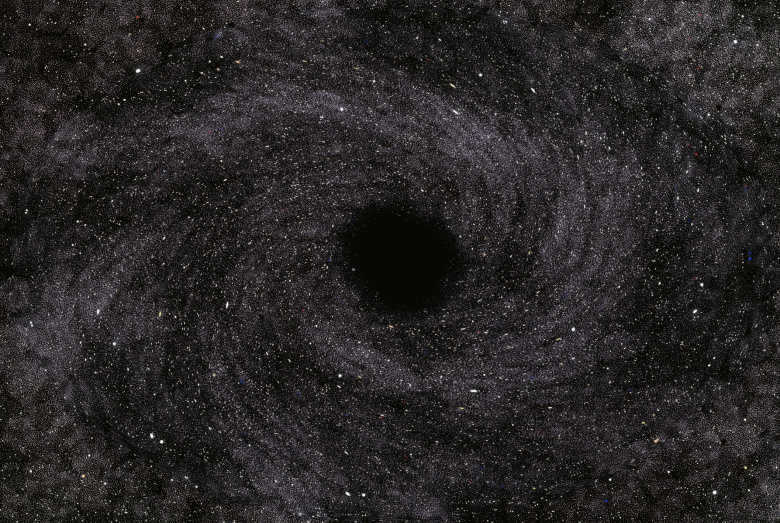
Scientists have discovered that these black holes have masses ranging from one million to ten billion times the mass of the Sun. Although the exact origin of supermassive black holes is still being investigated, it is believed that a significant portion of their mass comes from the high density of matter that is expected to gather in the center of a galaxy due to its gravitational pull.
This type of black hole will continue to attract and accumulate any gas that comes into its vicinity.
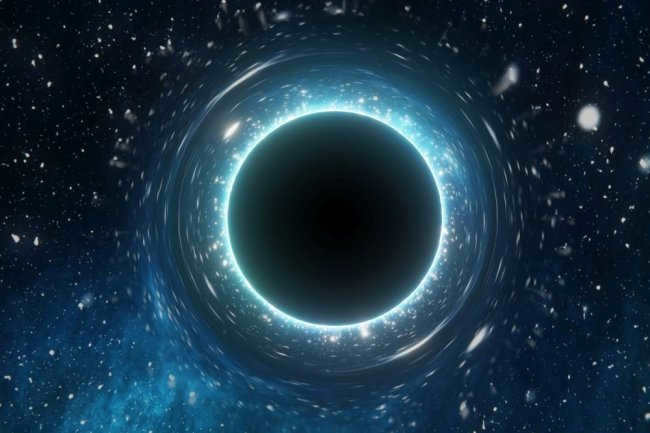
Black holes are present at the centers of nearly all significant galaxy formations, although the majority of them are not active enough to be considered active nuclei. The impact of these black holes on their surrounding galaxies has a significant influence on the formation of stars and the evolution of galaxies throughout the history of the universe. This process is currently being extensively researched.

